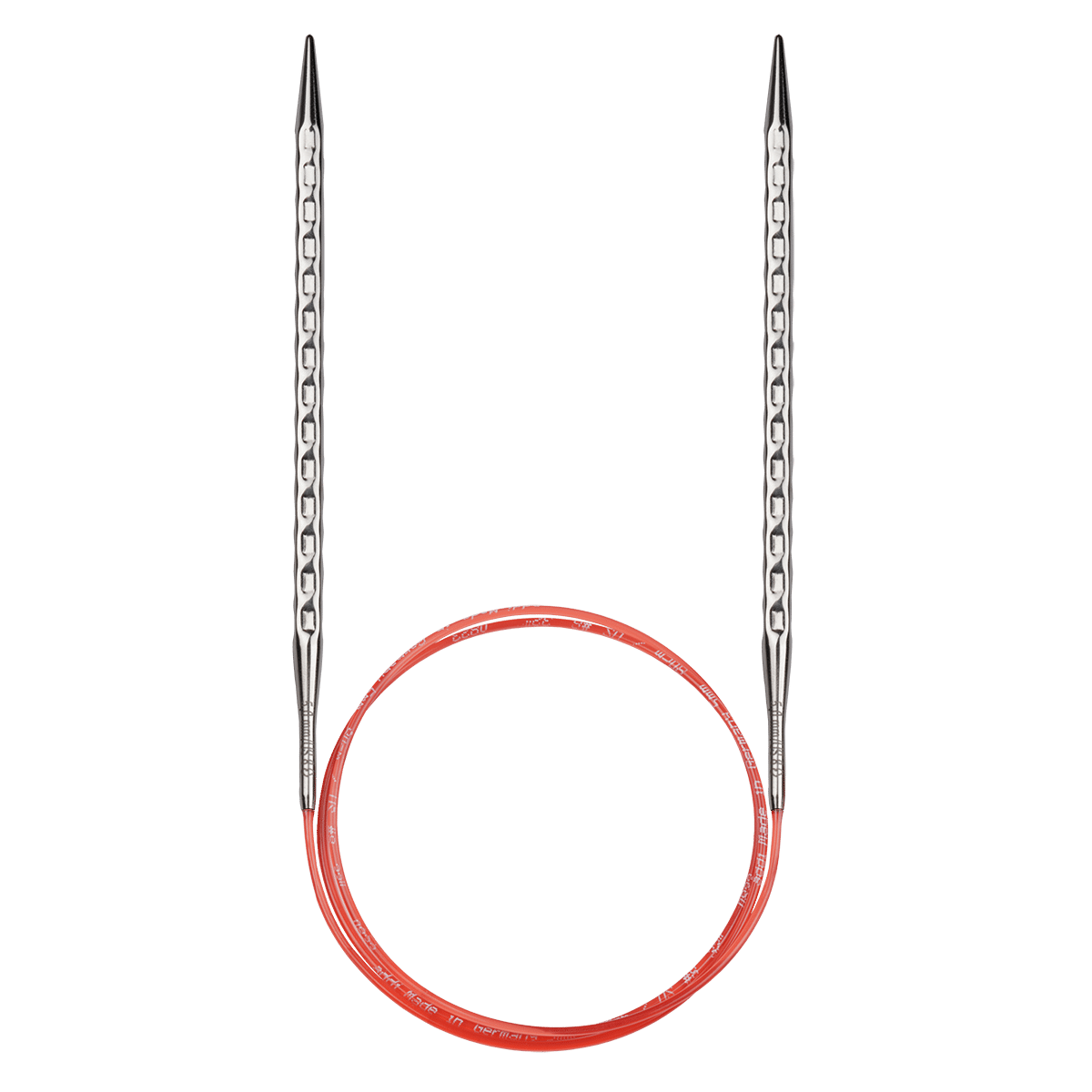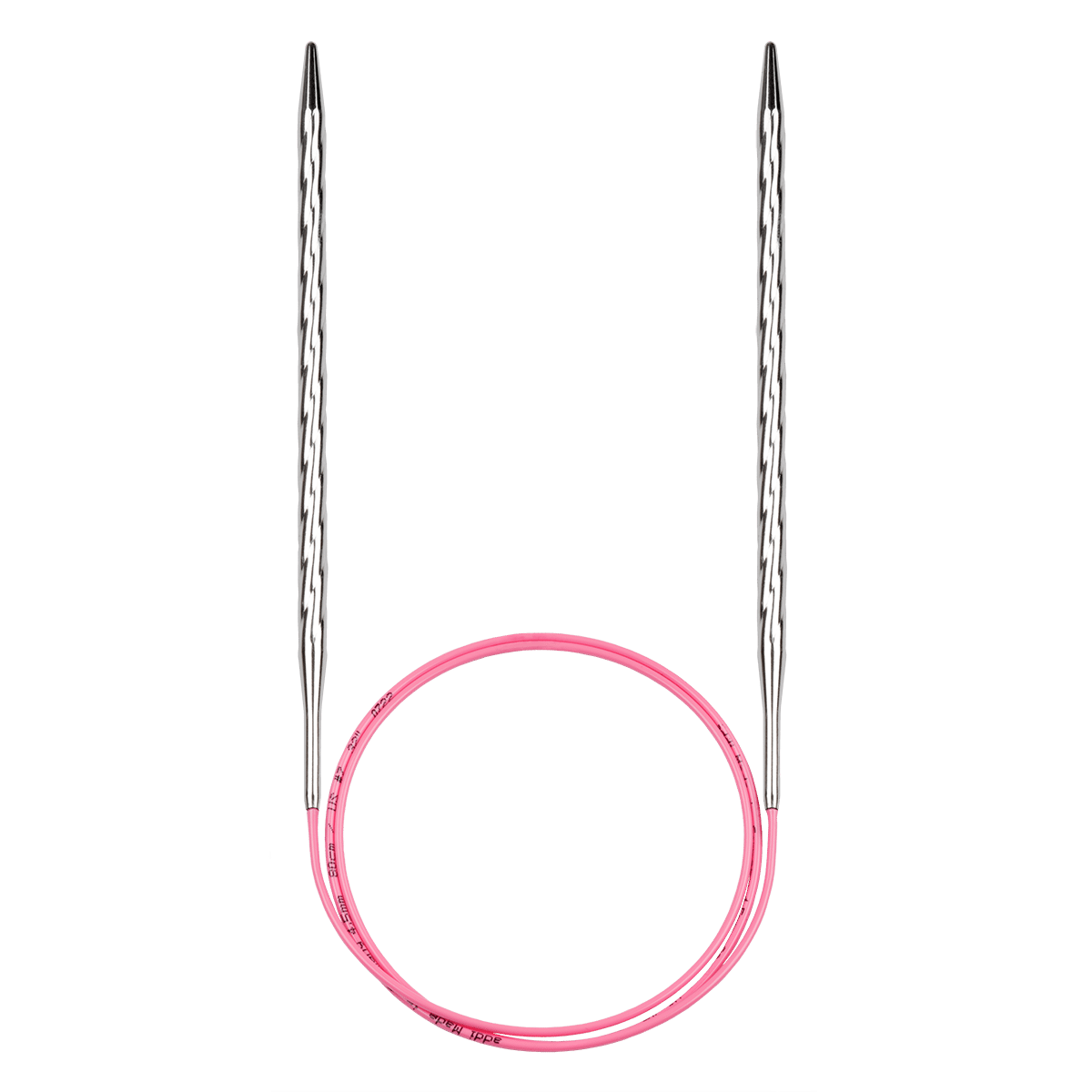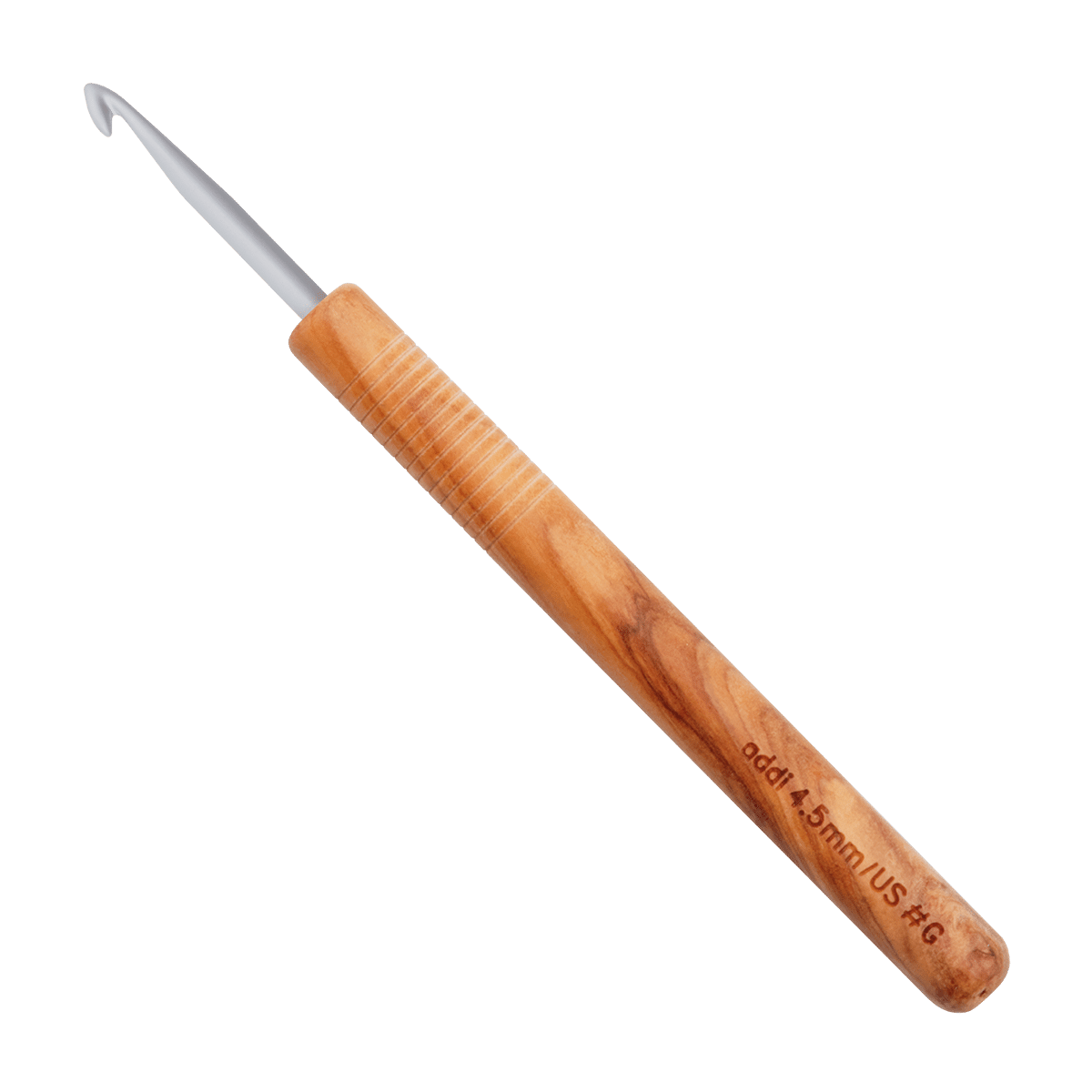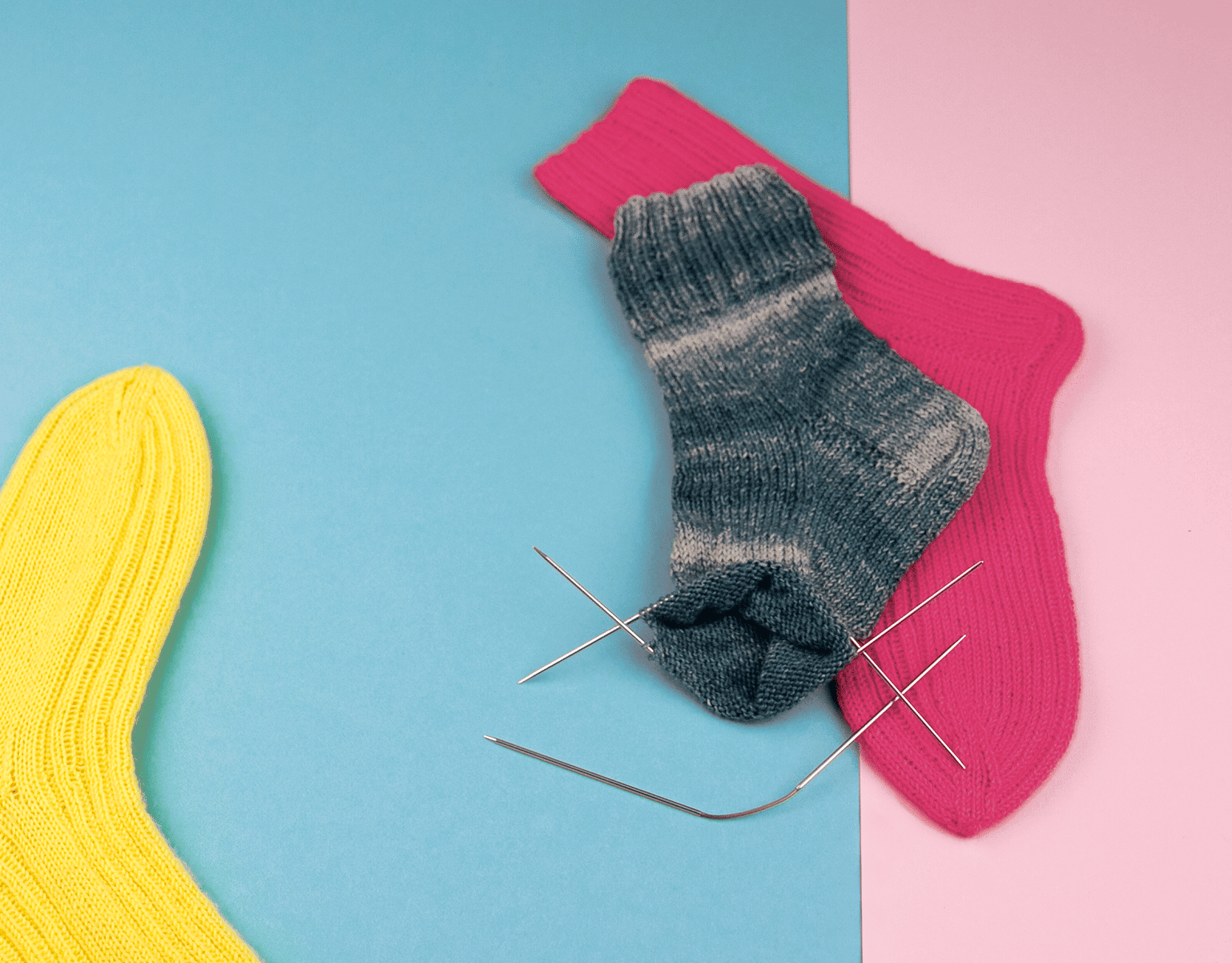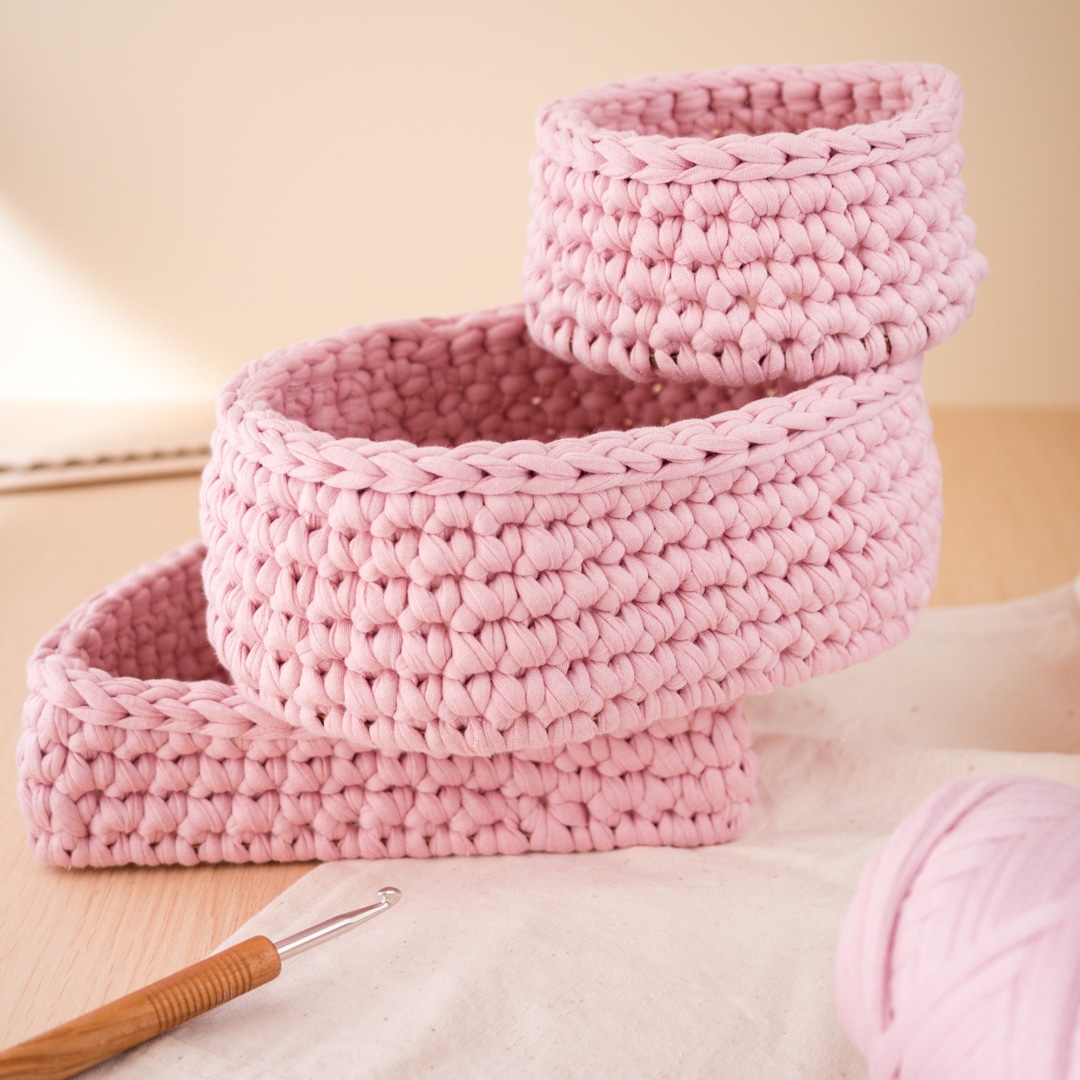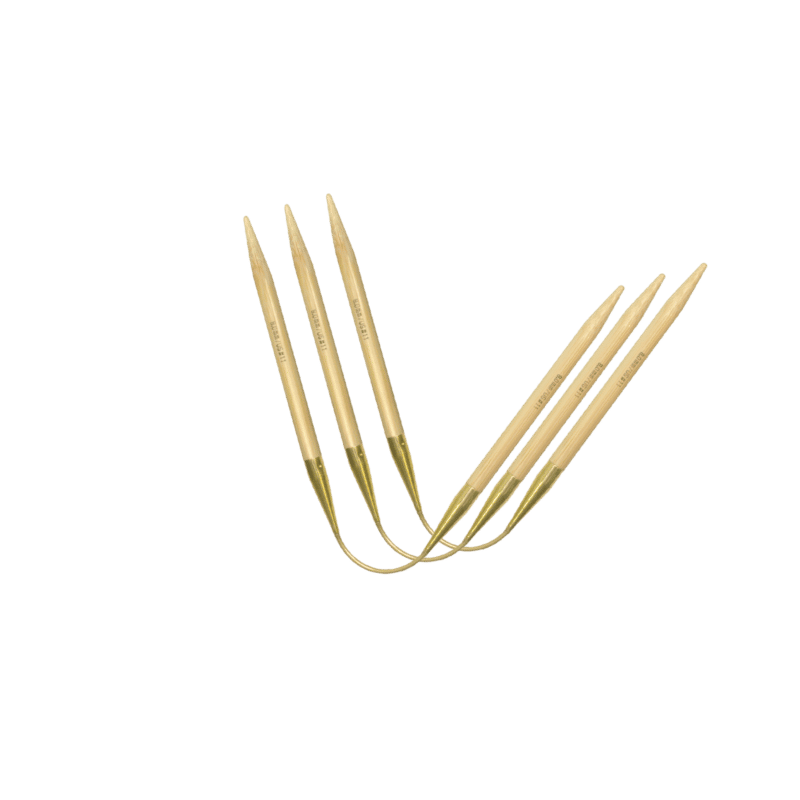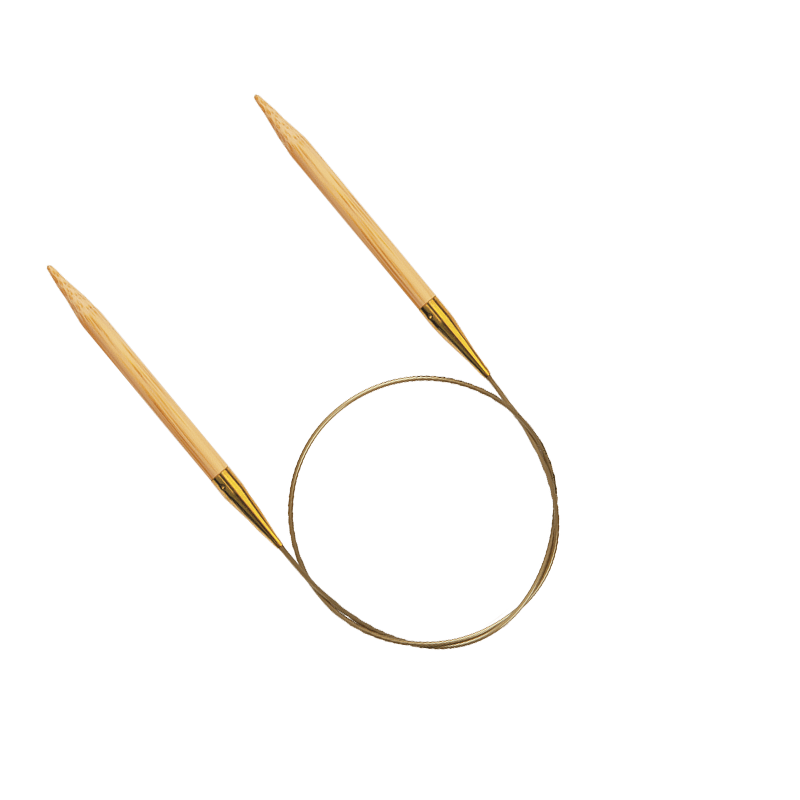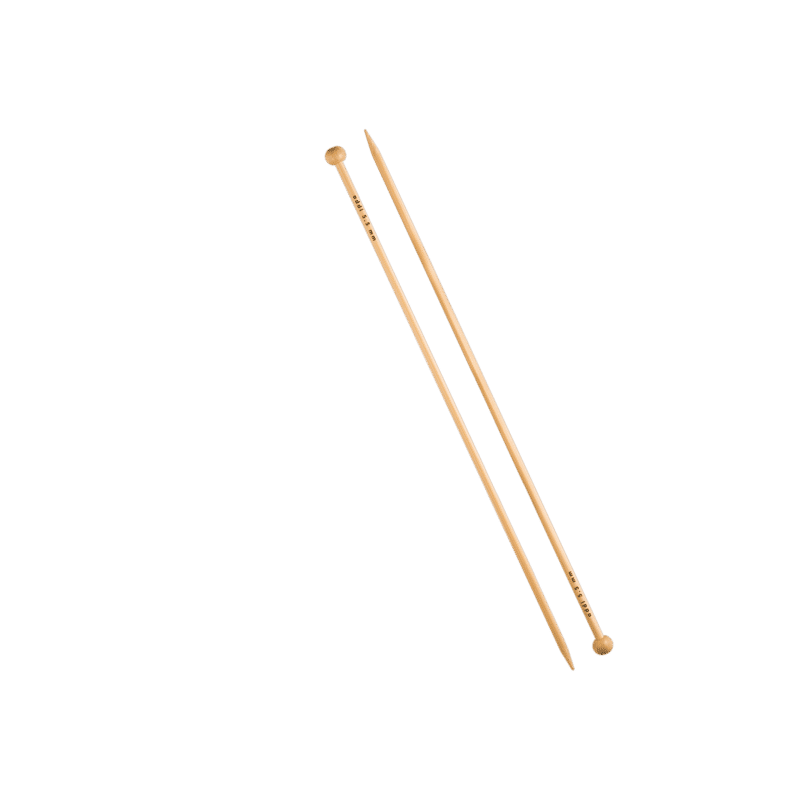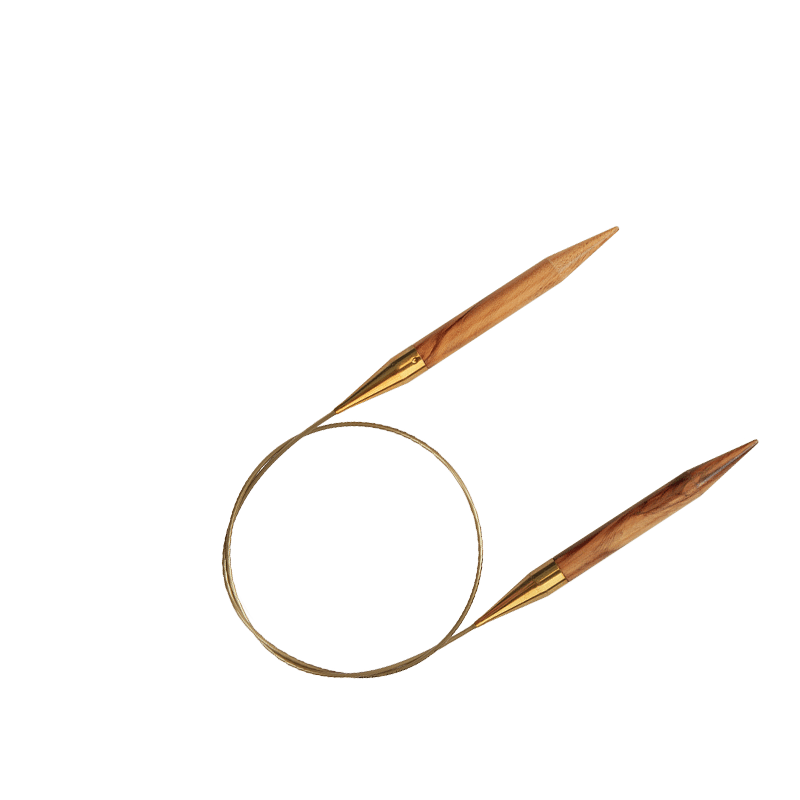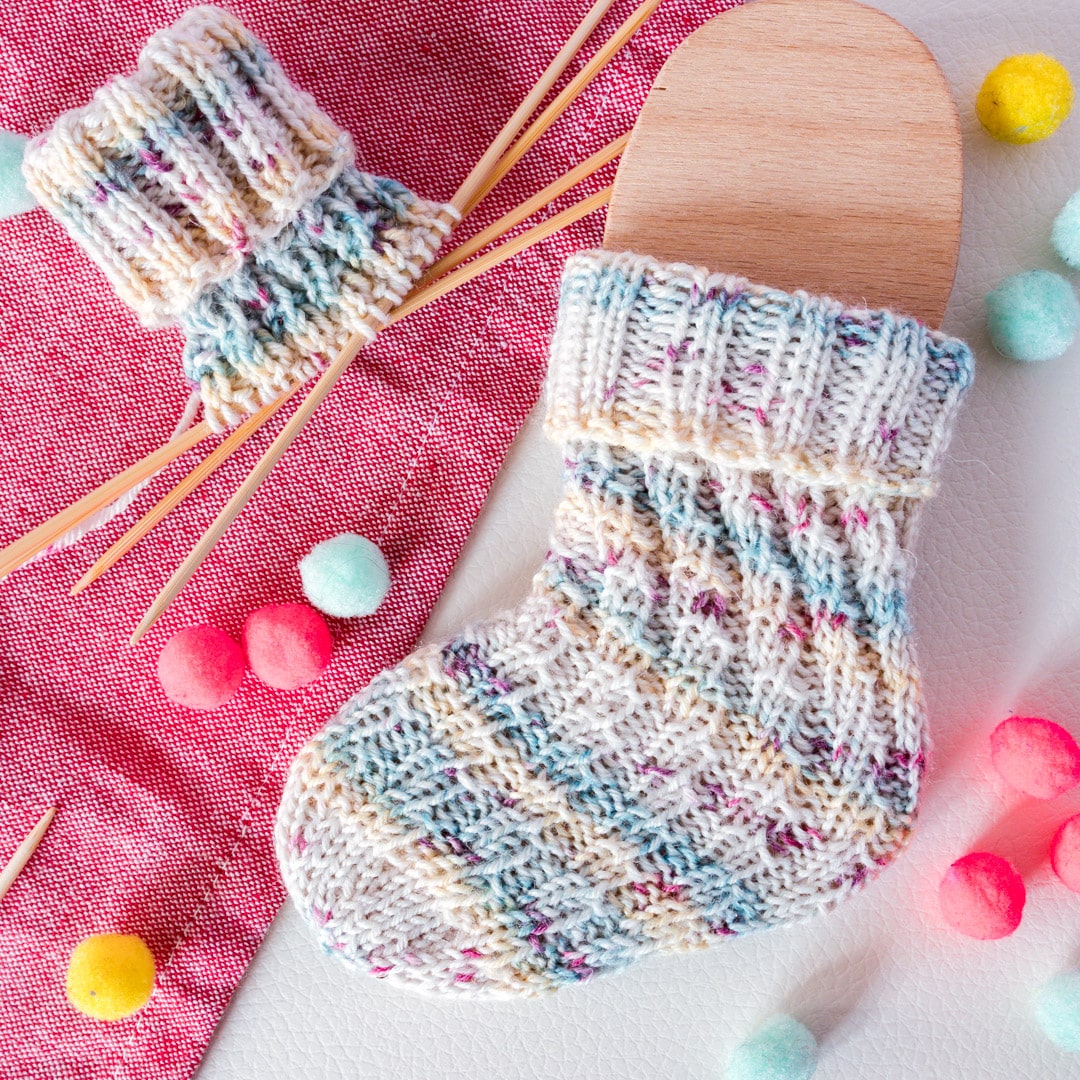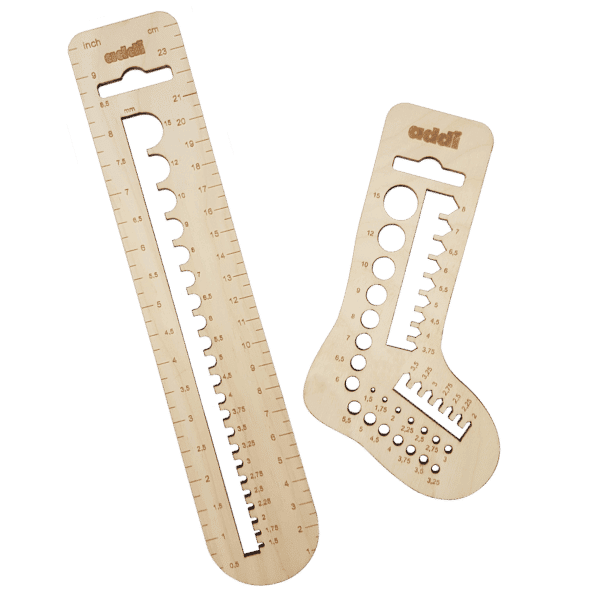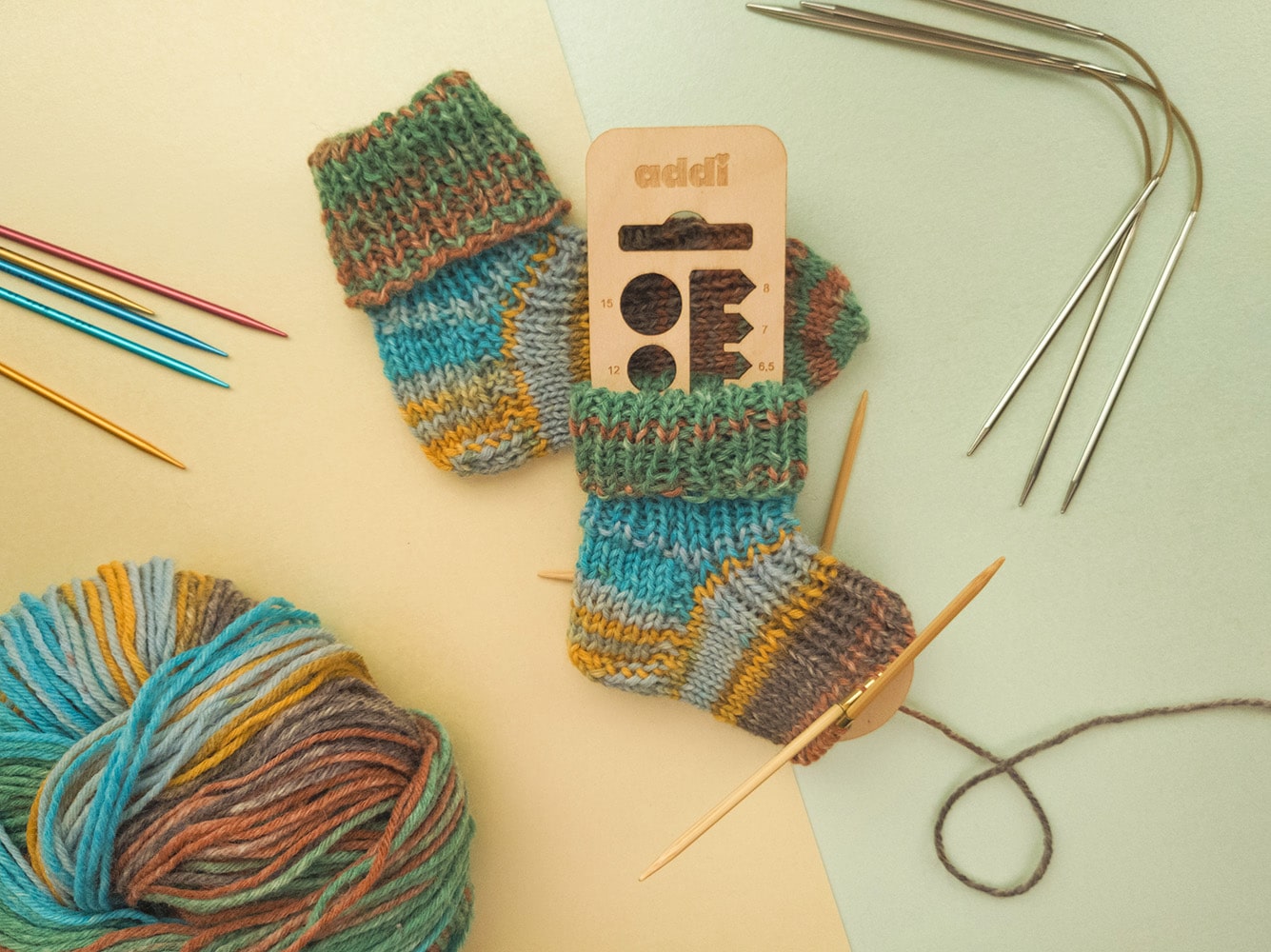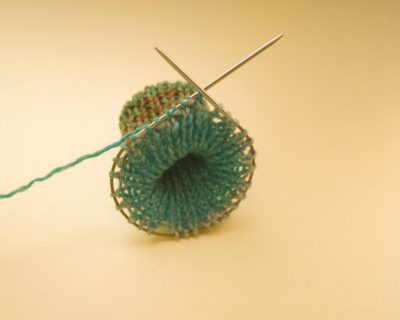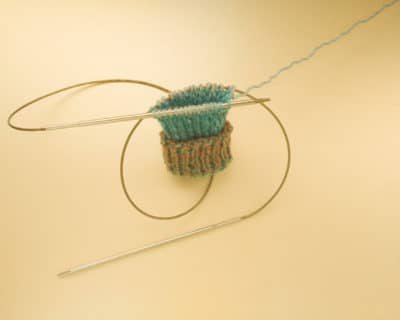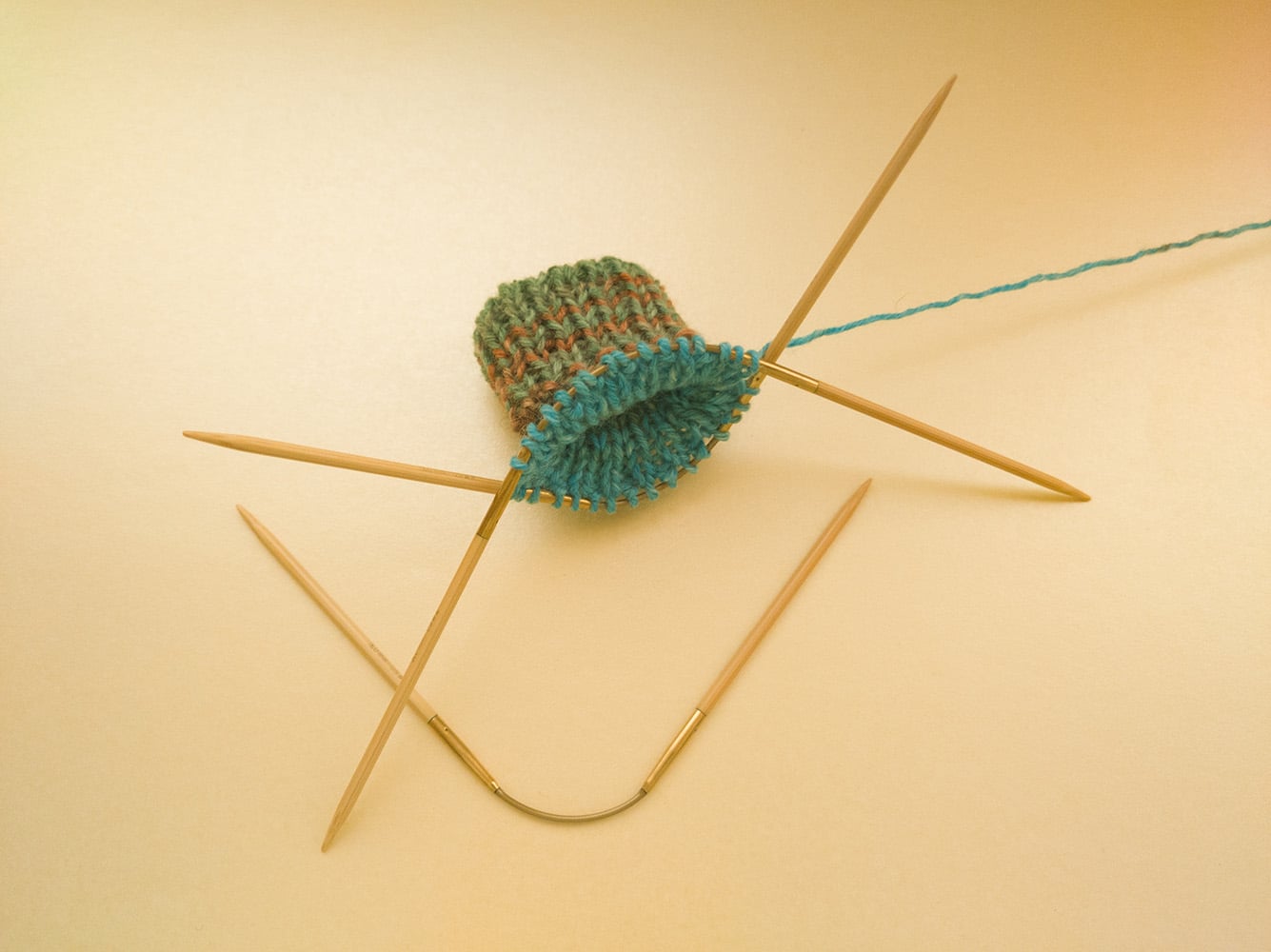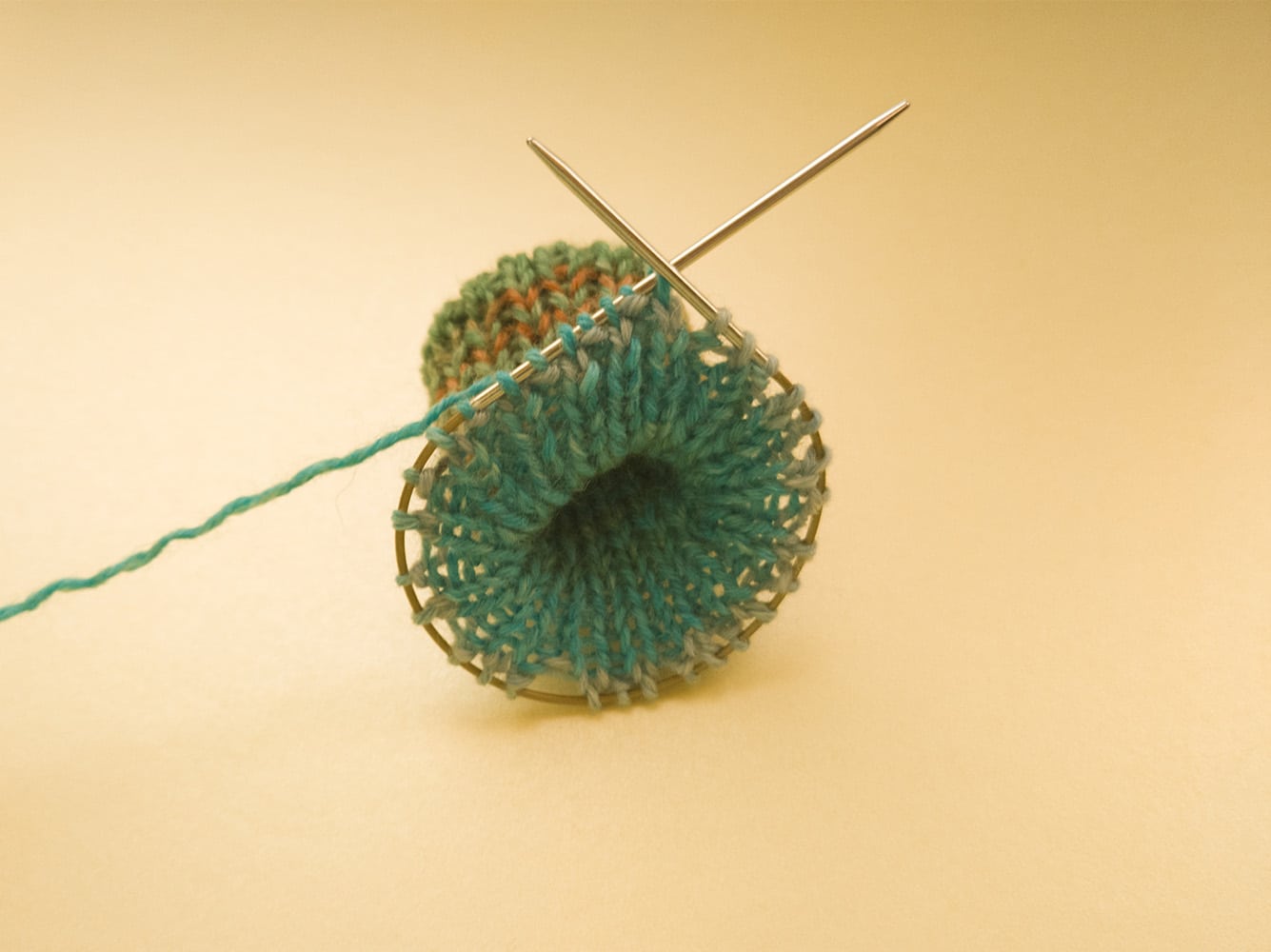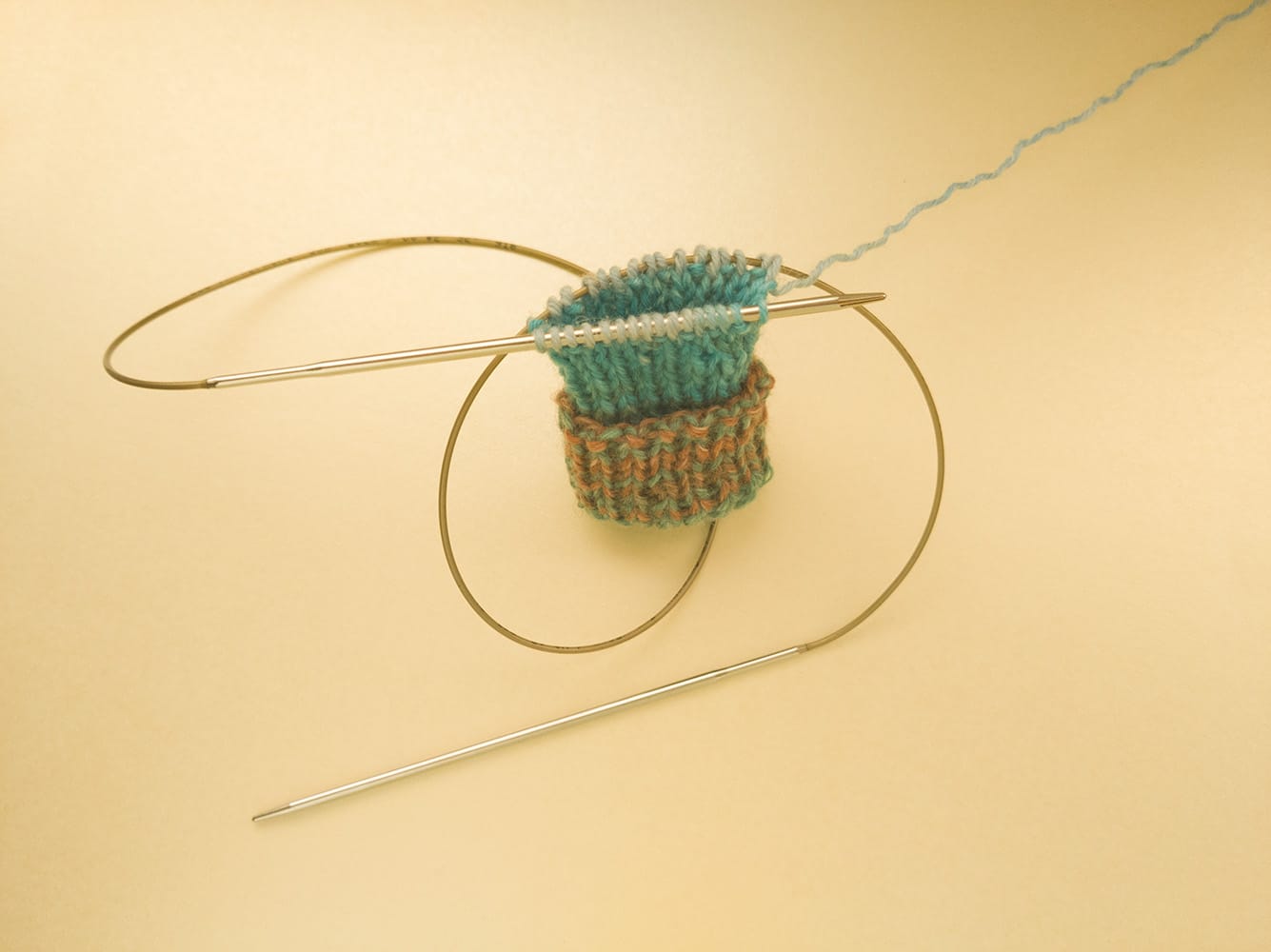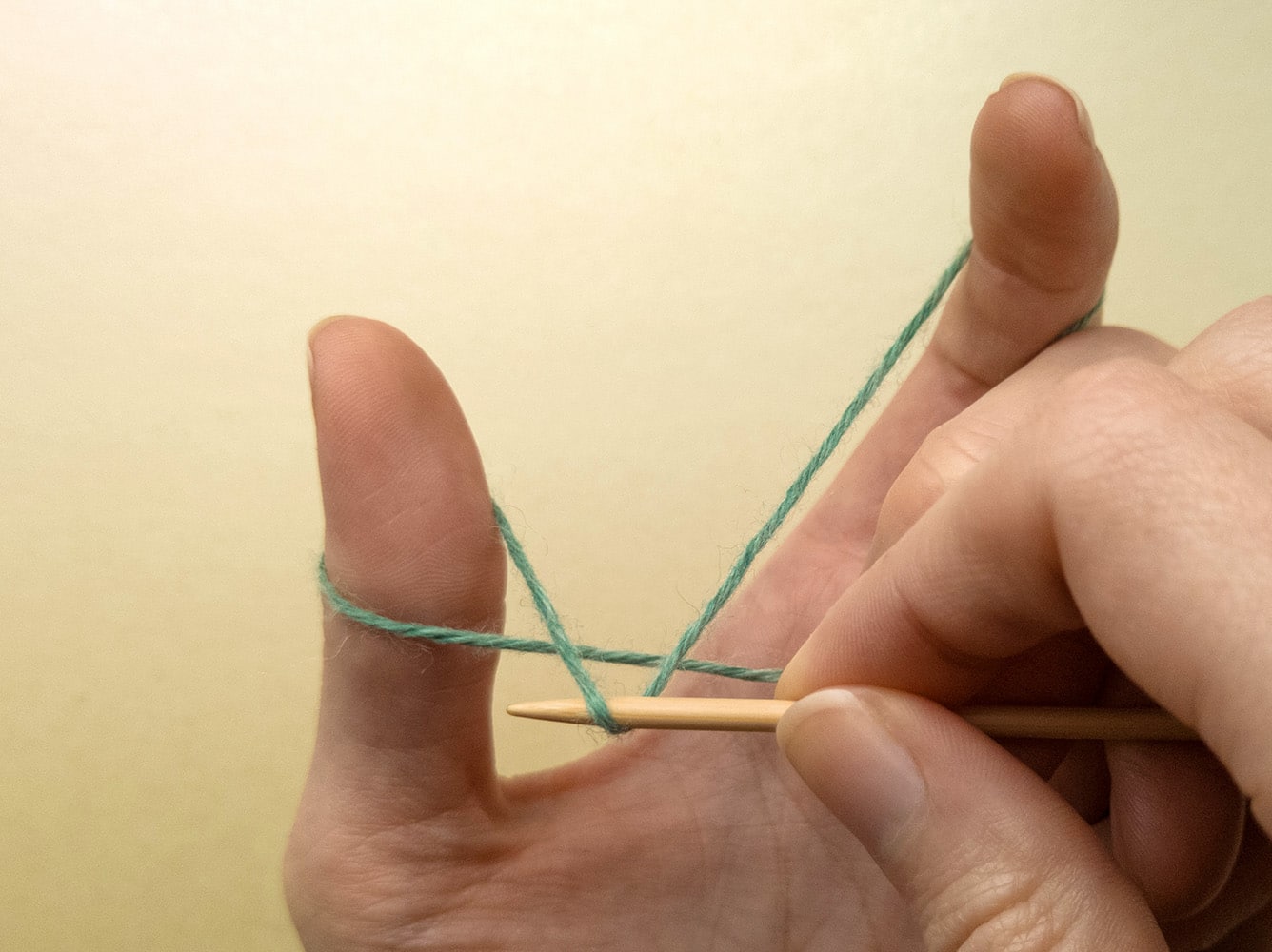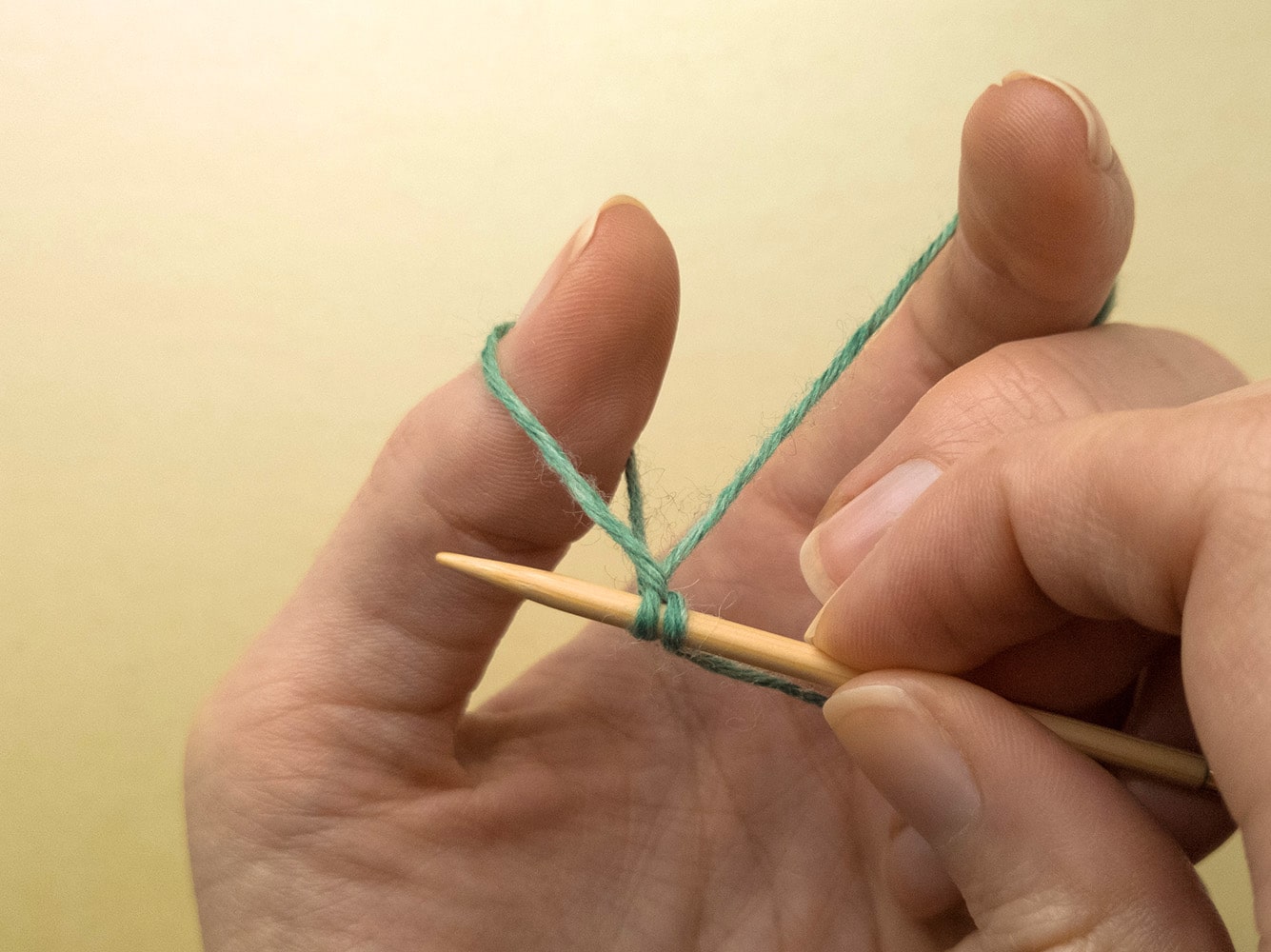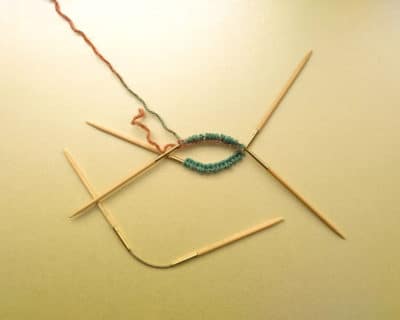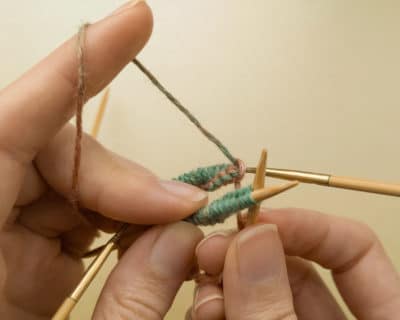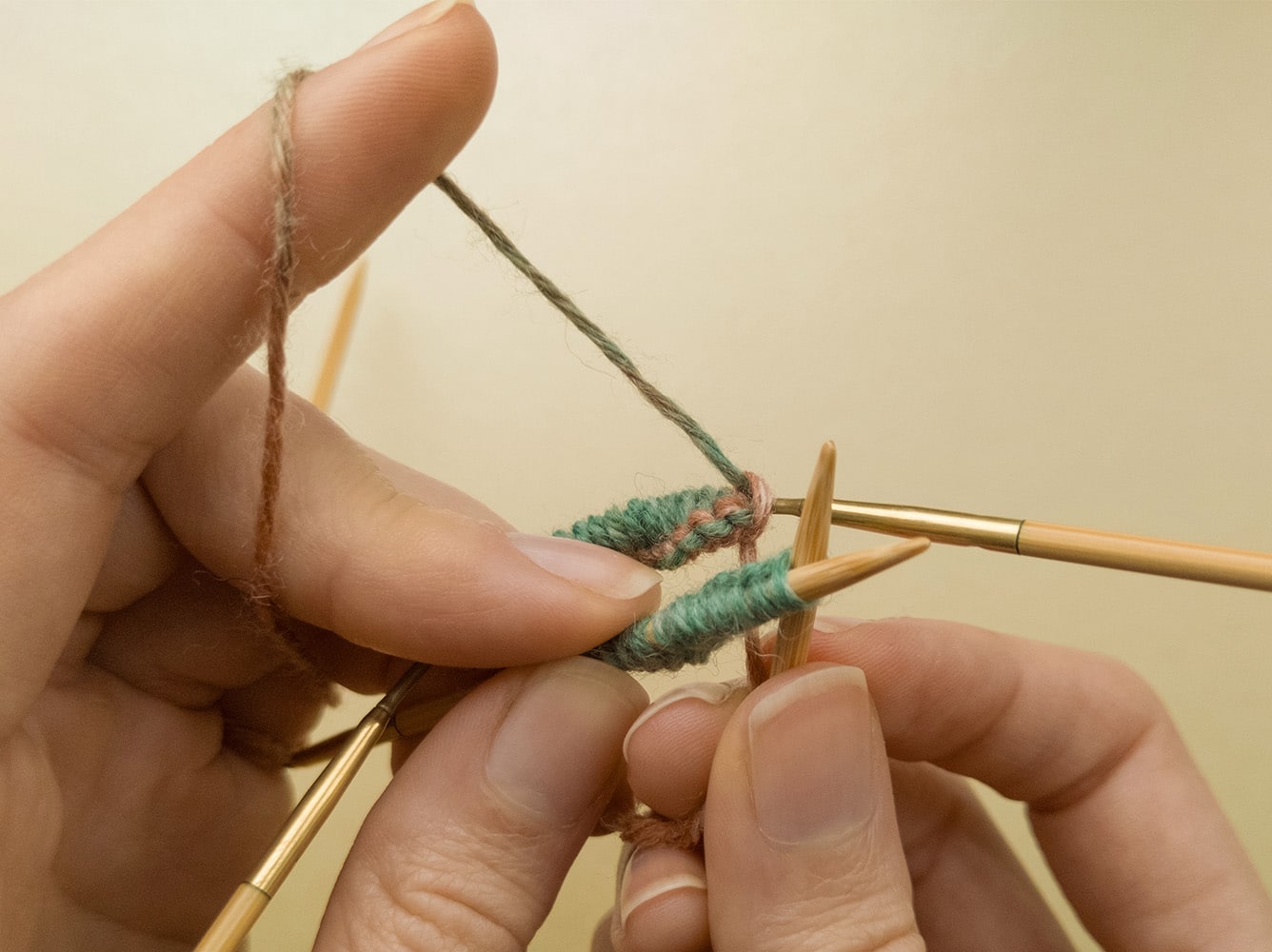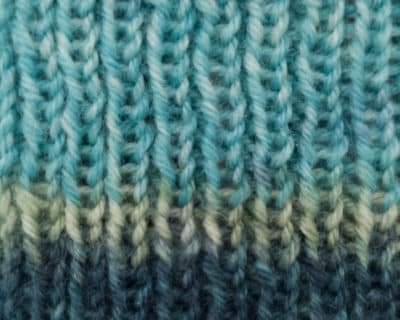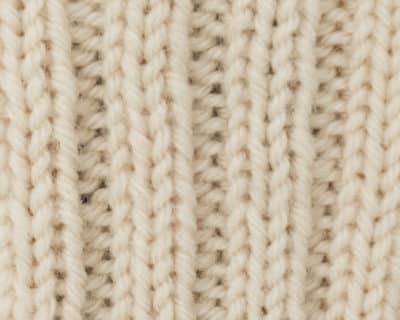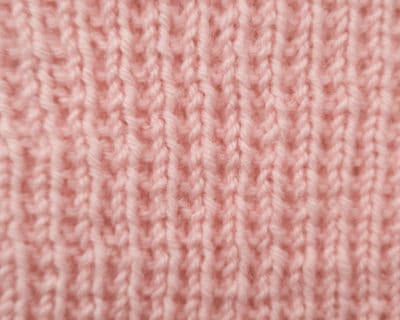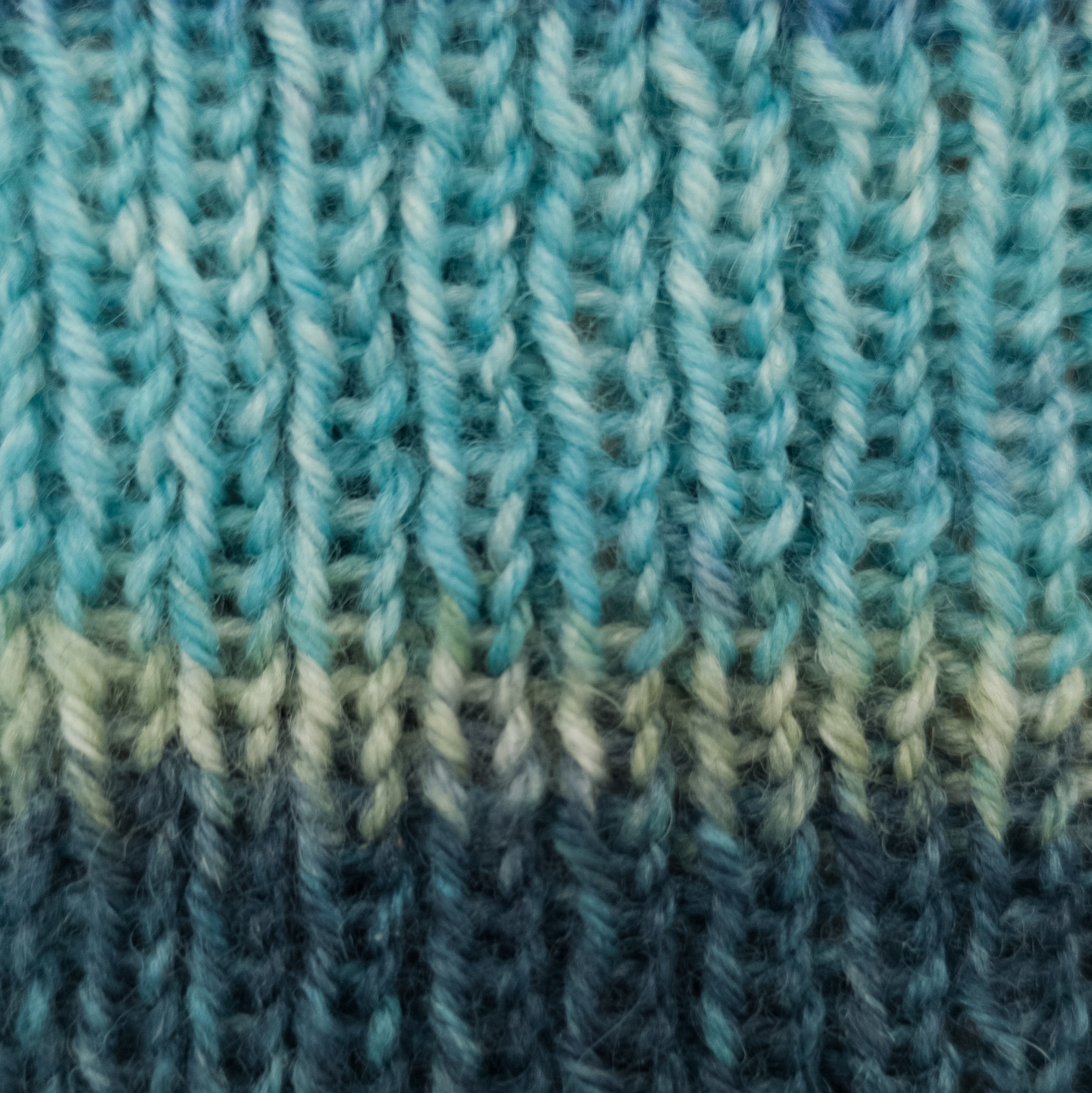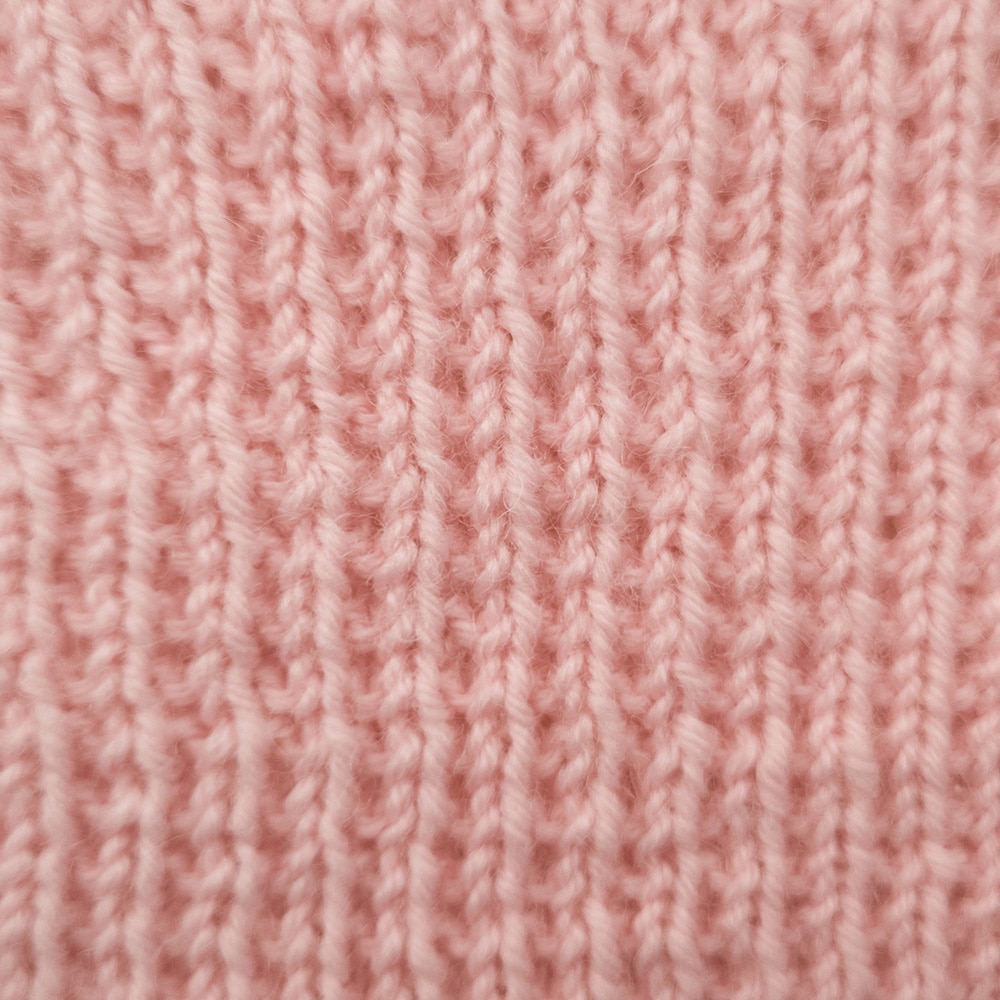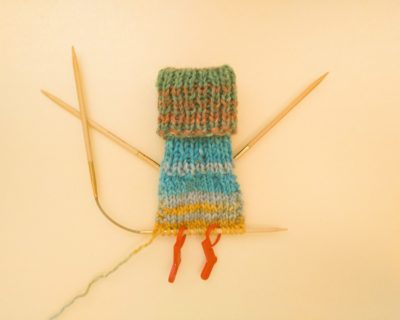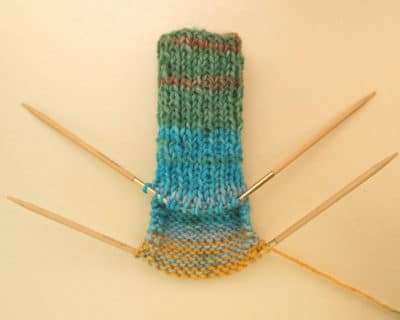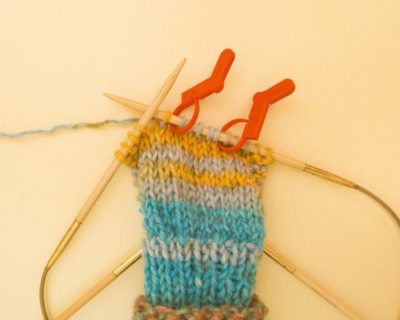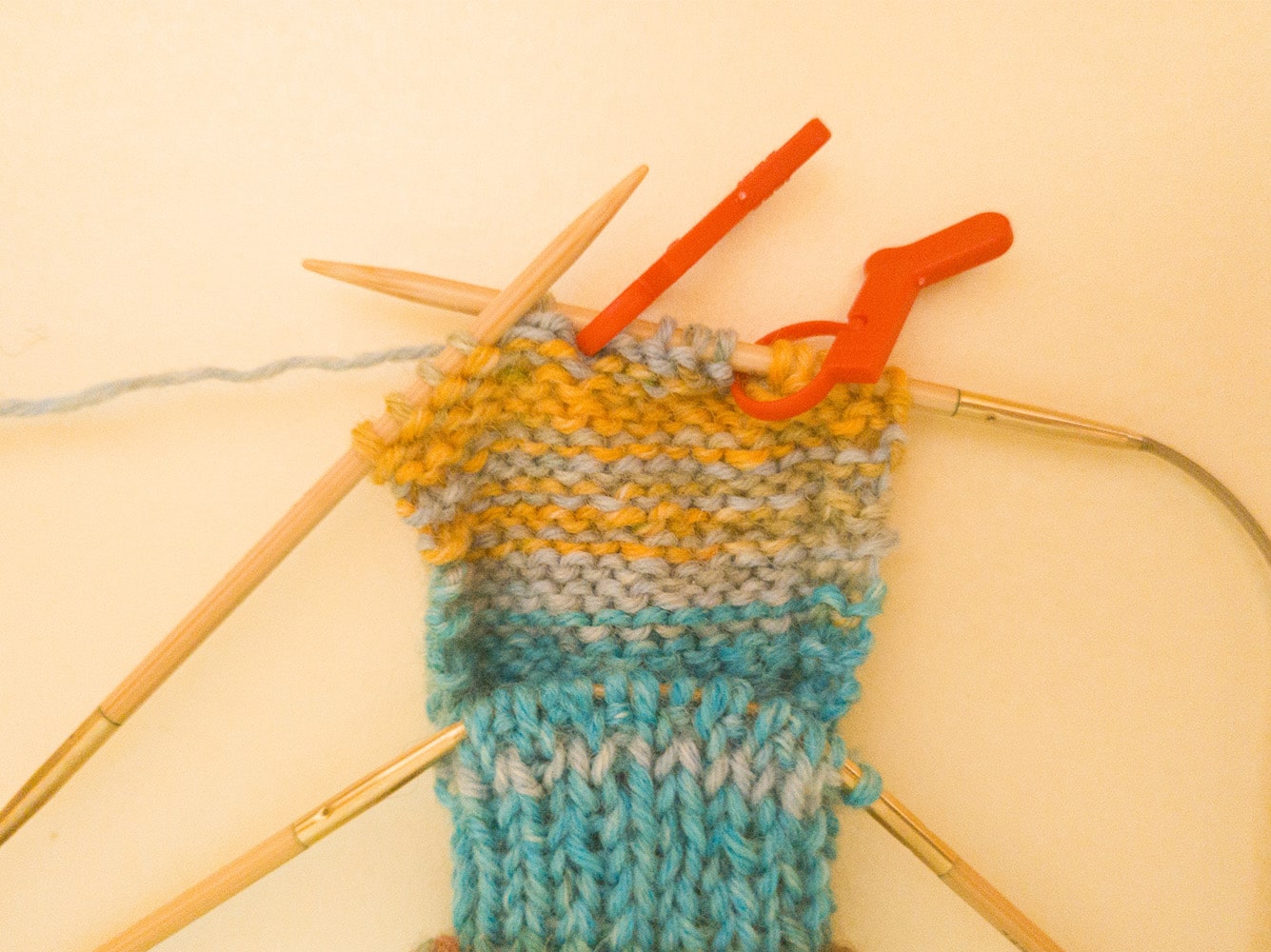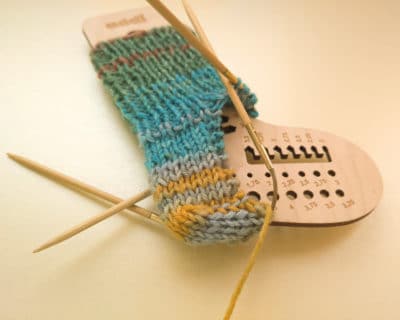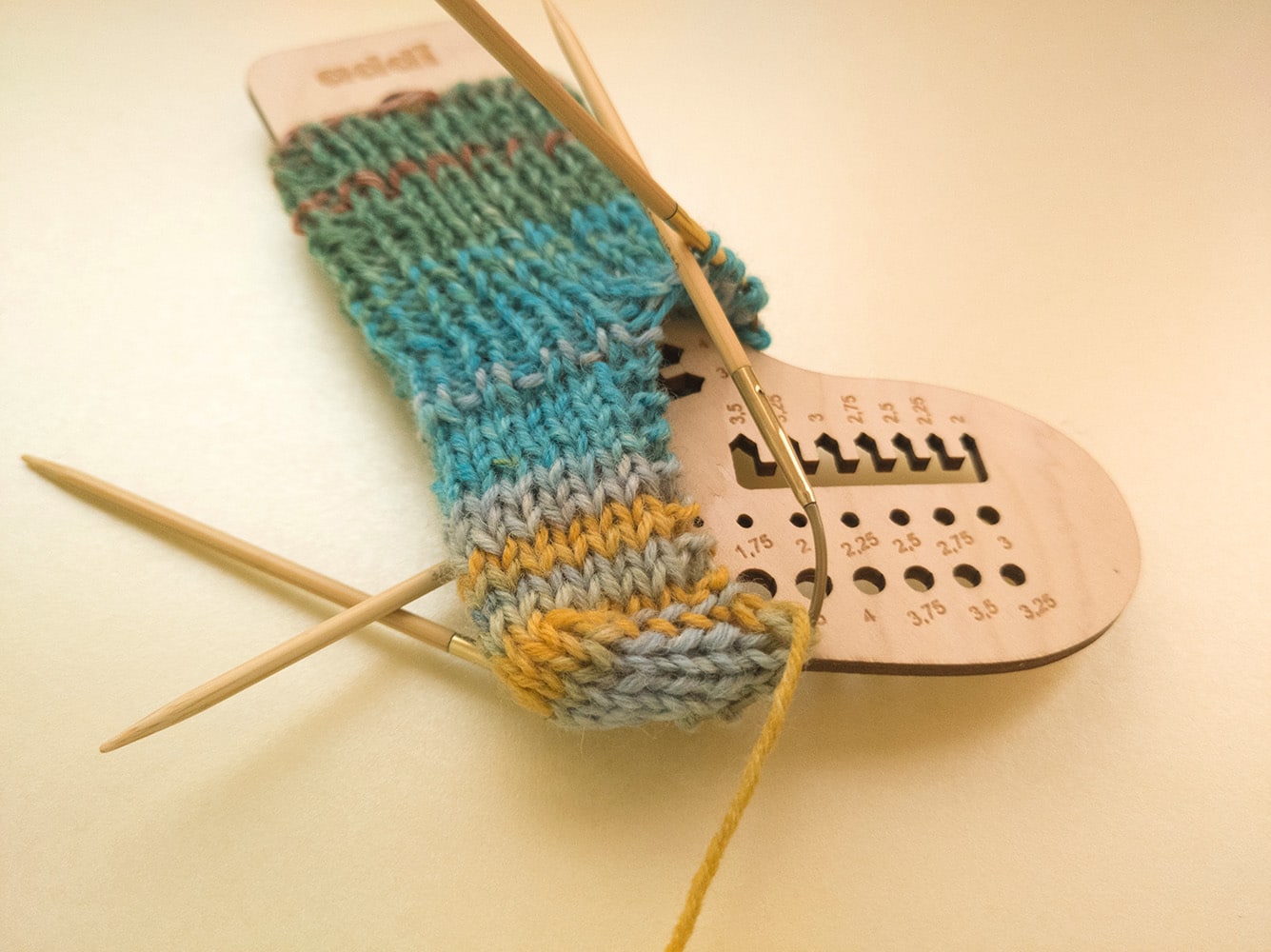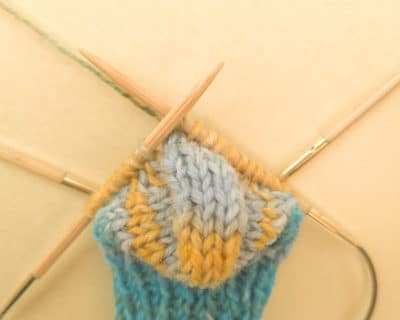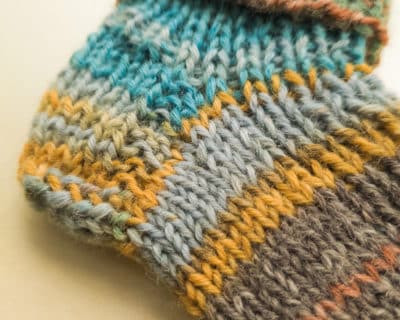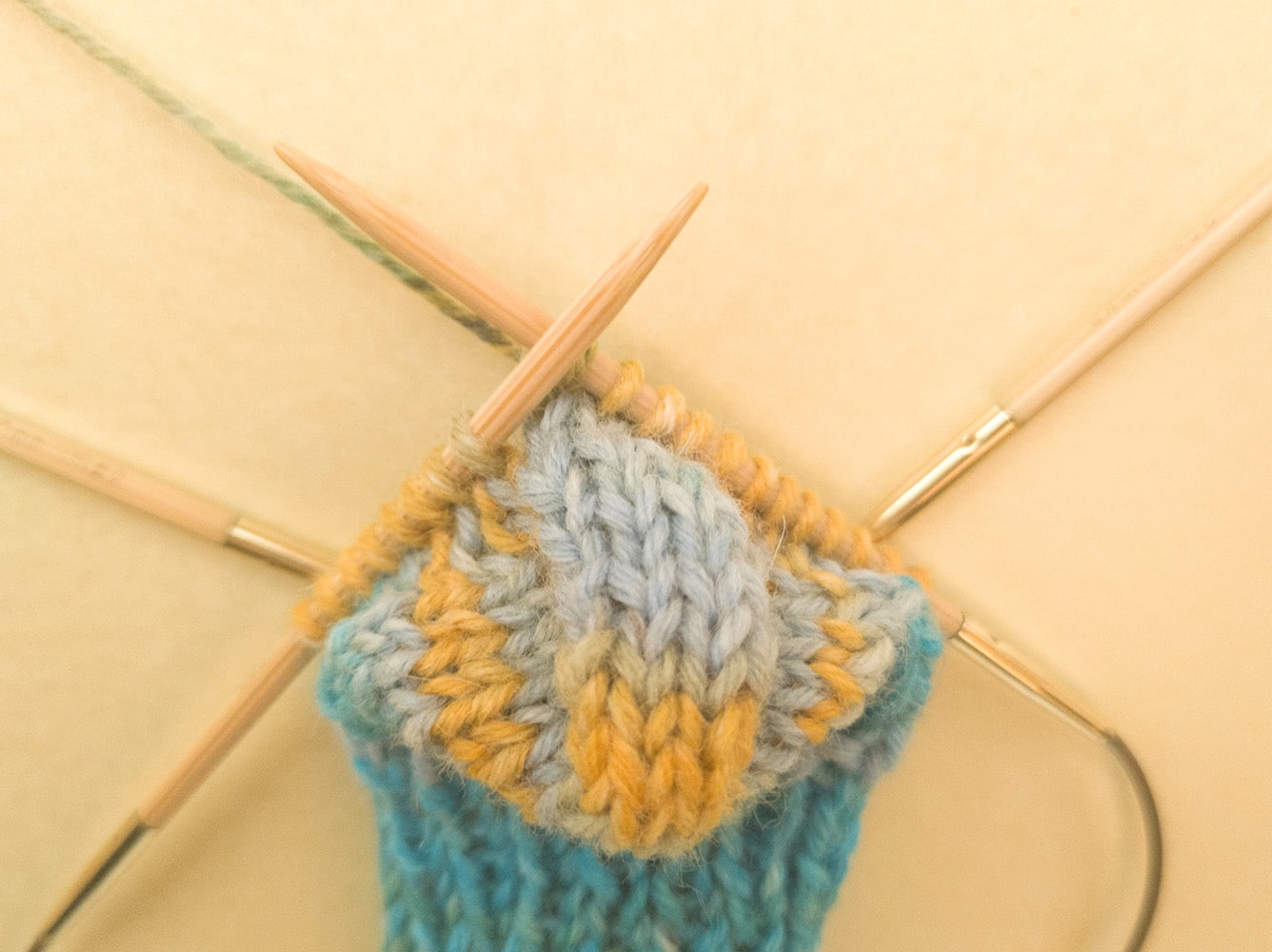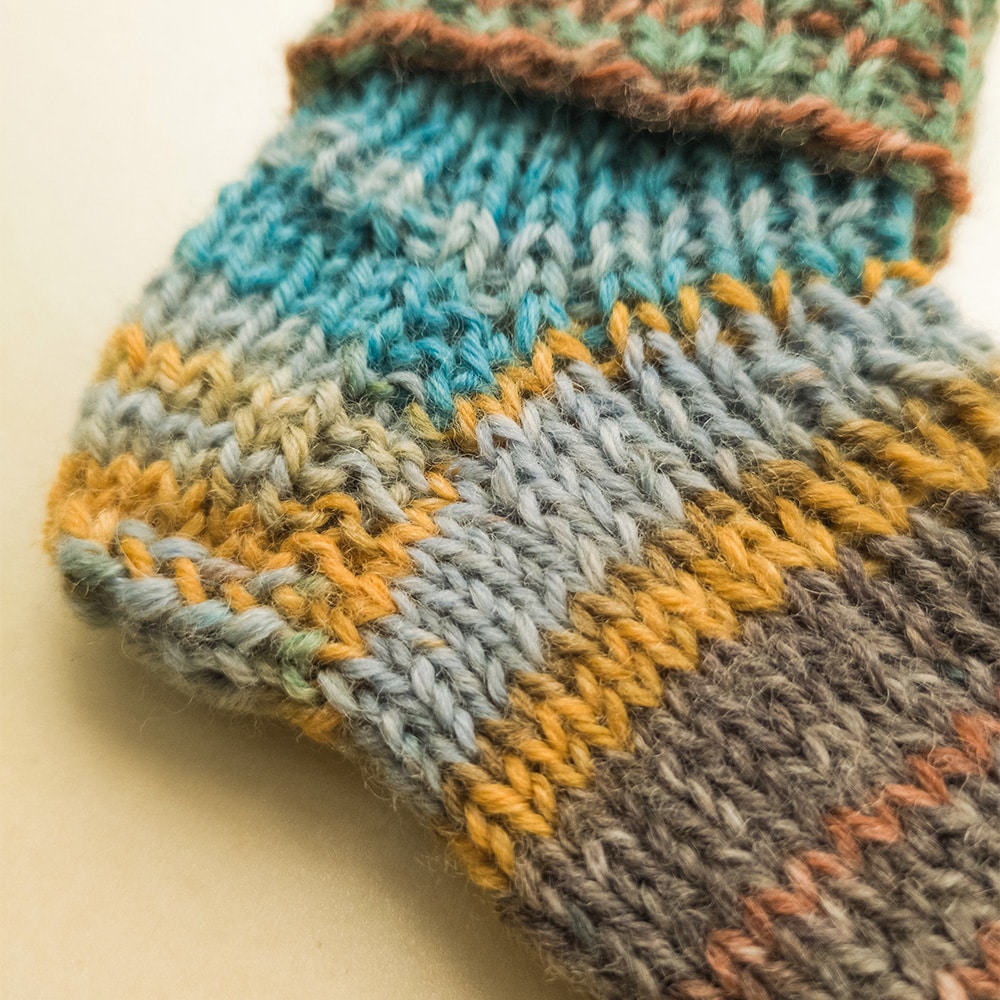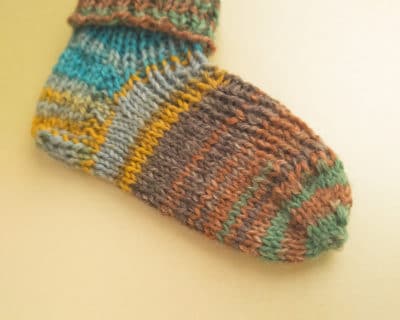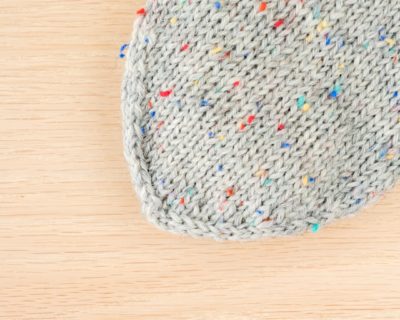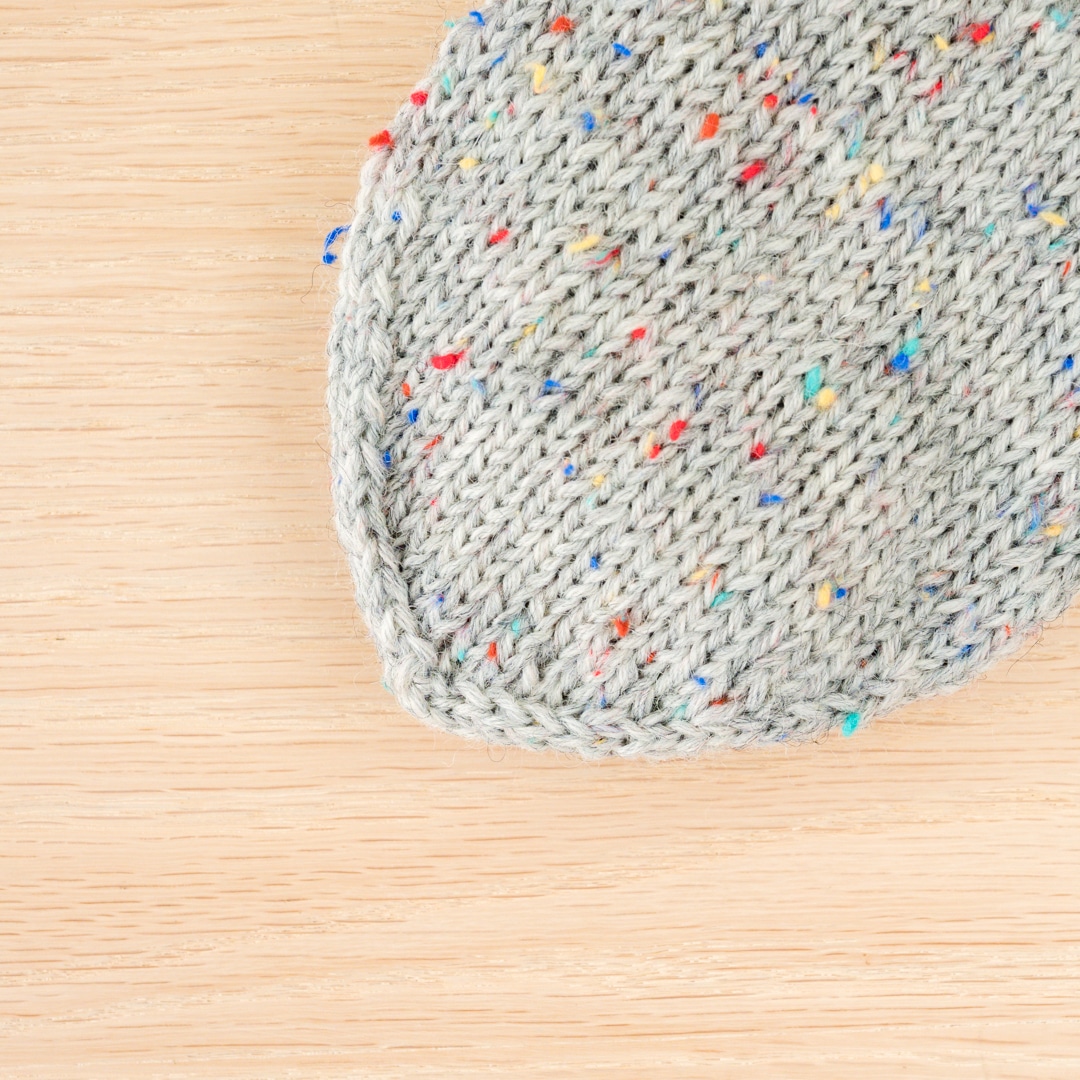Tutorial:
Knit baby socks with heel
Baby socks are quick to knit, for using up small sock yarn remnants, and a perfect gift for parents-to-be.
The instructions for baby socks can be knitted with 4-, 6- and 8-ply sock yarn and describe all the steps for different knitting needles such as addiCraSyTrio, double pointed needles and addiSockwonder.
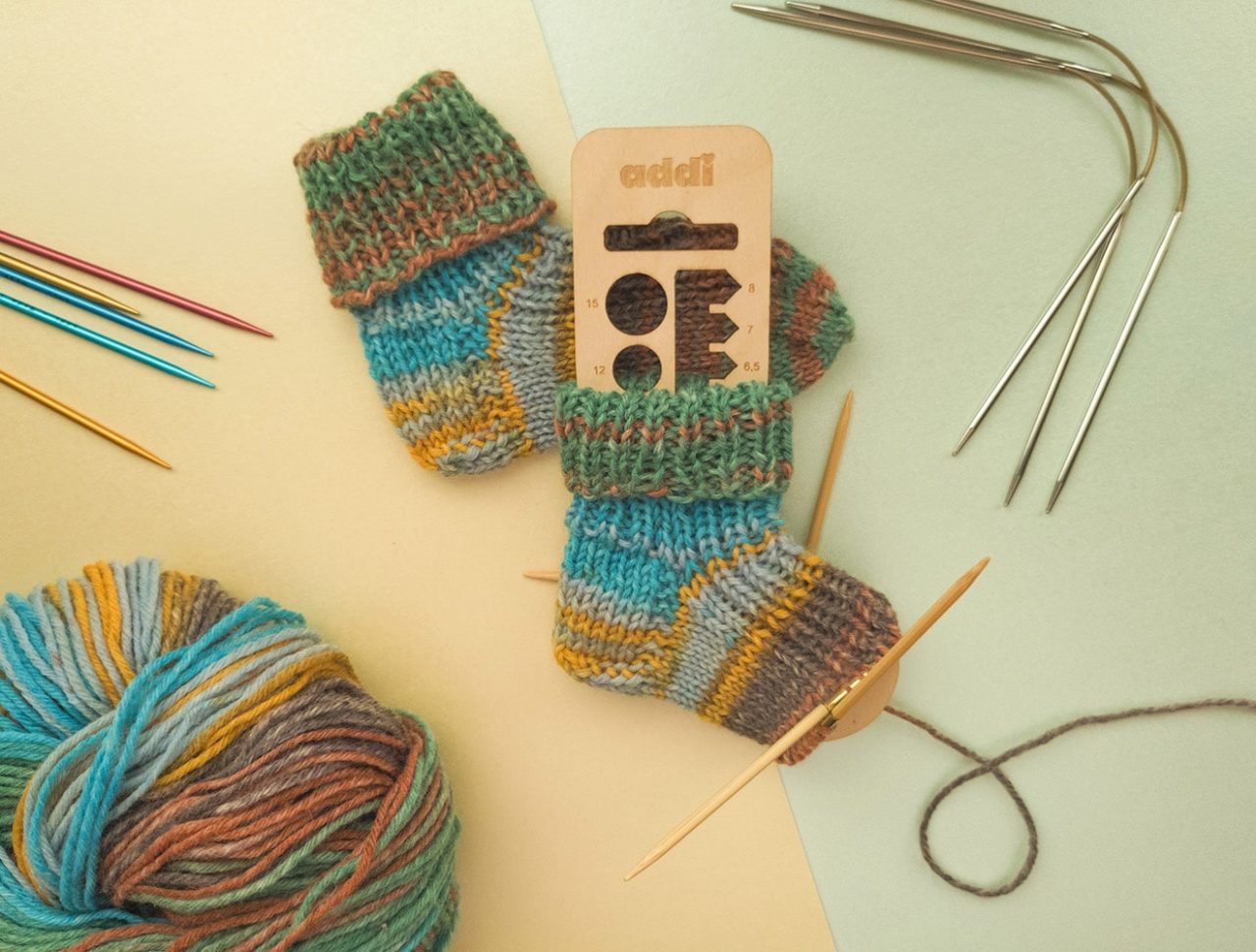
- Sock yarn 4-ply, 6-ply or 8-ply
- in our example Austermann Step 6, color 623 Malin, 6-ply sock yarn
- Knitting needles in the right size for the yarn. Our recommendations for small socks:
- Scissors
- darning needle
- stitch marker
Sizes in this instruction: Stitch count for shoe size (17-18/19-20/20-21/22-23) with 4-ply yarn
Further sizes for 6- and 8-ply in the sock calculator here in the app.
Babies are real sock kickers and manage to get rid of baby socks within seconds. Of course, they don't do this because their feet are too warm, but because they happen to move so elegantly.
To keep the sock on the foot, a classic version with a heel is ideal because it ensures a perfect fit. In these instructions, we describe the classic technique for knitting a sock from the cuff (top-down). If you prefer to knit from the tip (toe-up), you can find the basic instructions for toe-up socks from shoe size 17 here.
A tutorial for spiral socks is available here by Carosfummeley or directly in our addi2go app.

Babies are real sock kickers and manage to get rid of baby socks within seconds. Of course, they don't do this because their feet are too warm, but because they happen to move so elegantly.
To keep the sock on the foot, a classic version with a heel is ideal because it ensures a perfect fit. In these instructions, we describe the classic technique for knitting a sock from the cuff (top-down). If you prefer to knit from the tip (toe-up), you can find the basic instructions for toe-up socks from shoe size 17 here.
A tutorial for spiral socks is available here by Carosfummeley or directly in our addi2go app.

Knit baby socks with heel
Babies are real sock kickers and manage to get rid of socks within seconds. Of course, they don't do this because their feet are too warm, but because they happen to move so elegantly.
To keep the sock on the foot, a classic version with a heel is ideal because it ensures a perfect fit.
In these instructions, we describe the classic technique for knitting a sock from the cuff (top-down). If you prefer to knit from the tip (toe-up), you can find the basic instructions for toe-up socks from shoe size 17 here.
How much sock yarn is needed for baby socks
- A pair of spiral socks for a newborn requires approx. 20 g of sock yarn (4-ply).
- For larger baby socks with a heel (up to size 22), approx. 30 g of sock yarn (4-ply) is sufficient.
A classic sock yarn made from wool with a small amount of polyamide is also a good choice for baby feet. It keeps them warm, allows them to breathe and can also be washed in the washing machine on the wool program. Merino sock yarn is particularly soft.
Tip: For summer babies or baby socks that are to be worn in shoes, a thin 4-ply sock yarn is well suited. If it is a winter baby, a thicker 6-ply yarn is also a good choice.
What size baby socks should be
- For newborns (0-6 months) shoe size EU 17/18 (UK 3-4 JNR)
- For babies (6-12 months) shoe size EU 19/20 (UK 4-5 JNR)
- For babies (12-18 months) shoe size EU 21/22 (UK 6-7 JNR)
- For babies (18-24 months) shoe size EU 23/24 (UK 7-8 JNR)
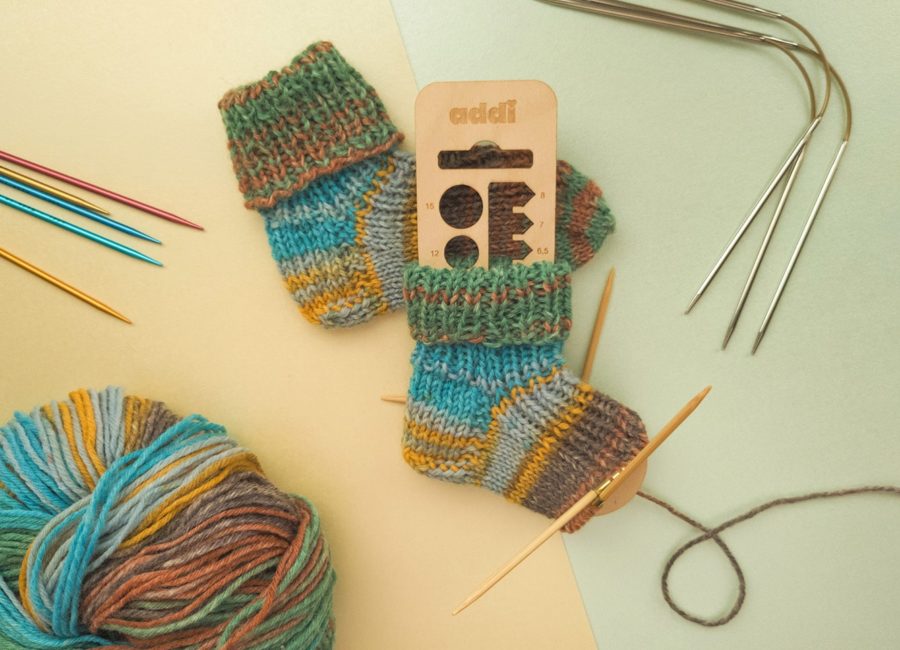
What size baby socks should be
- For newborns (0-6 months) shoe size EU 17/18 (UK 3-4 JNR)
- For babies (6-12 months) shoe size EU 19/20 (UK 4-5 JNR)
- For babies (12-18 months) shoe size EU 21/22 (UK 6-7 JNR)
- For babies (18-24 months) shoe size EU 23/24 (UK 7-8 JNR)
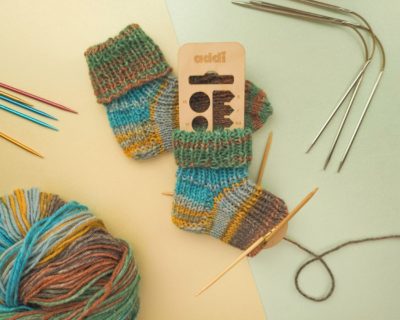
How many stitches to cast on for baby socks
The required number of stitches to be cast on according to shoe size and yarn (4-ply, 6-ply or 8-ply) can be found in our extensive sock charts. The short version of the chart can be found directly here in the instructions.
In our addi2go app you will find the sock charts as a sock calculator. Simply select your shoe size and start knitting.
In the line "Stitches total CO" shows the total number of stitches that should be evenly distributed across all needles. The heel is knitted over half of these stitches afterward.
The numbers in the text refer to size (17-18/19-20/20-21/22-23) UK (3-4/4-5/6-6/7-8), 4-ply sock yarn.
Sock chart 4-ply
- Sock wool 4‐ply (420m, 100g) (384 yd, 3.5 oz)
- for Needle size 2,5-3 mm / US 1-2
| Shoe size EU | 17 / 18 | 19 / 20 | 20 / 21 | 22 / 23 | 24 / 25 |
| Schuhgröße UK | 3-4 JNR | 4-5 JNR |
5-6 JNR | 6-7 JNR |
7-8 JNR |
| Stitches total CO | 36 | 36 | 40 | 40 | 44 |
| Distribution of sts for Classic heel | 6/6/6 | 6/6/6 | 7/6/7 | 7/6/7 | 7/8/7 |
| Foot length to beginning of toe (cm/inch) |
8 / 3.2 | 9 / 3.5 | 10 /4 | 11 / 4.3 | 12 / 4.7 |
| Total foot lenghts (cm/inch) |
10 /4 | 11,5 / 4.5 | 13 / 5.1 | 14,5 / 5.7 | 16 / 6.3 |
| Classic Rounded Toe Decrease in the 3th round | 1x | 1x | 1x | 1x | 1x |
| Classic Rounded Toe Decreases in the 2th round | 3x | 3x | 3x | 3x | 3x |
| Classic Rounded Toe Decreases in every round | 3x | 3x | 4x | 4x | 5x |
Sock chart 6-ply
- Sock wool 6‐ply (380m, 150g) (347 yd, 5.3 oz)
- for Needle size 3-4 mm / US 2-6
| Shoe size EU | 17 / 18 | 19 / 20 | 20 / 21 | 22 / 23 | 24 / 25 |
| Shoe size UK | 3-4 JNR | 4-5 JNR |
5-6 JNR | 6-7 JNR |
7-8 JNR |
| Stitches total CO | 28 | 28 | 32 | 32 | 36 |
| Distribution of sts for Classic heel |
4/6/4 | 4/6/4 | 5/6/5 | 5/6/5 | 7/8/7 |
| Foot length to beginning of toe (cm/inch) |
8 / 3.2 | 9 / 3.5 | 10 / 4 | 11 / 4.3 | 12 / 4.7 |
| Total foot lenghts (cm/inch) |
10 / 4 | 11,5 / 4.5 | 13 / 5.1 | 14,5 / 5.7 | 16 / 6.3 |
| Classic Rounded Toe Decreases in the 2th round | 2x | 2x | 2x | 2x | 3x |
| Classic Rounded Toe Decreases in every round |
3x | 3x | 4x | 4x | 4x |
Sock chart 8-ply
- Sock wool 8‐ply (300m, 150g) (274 yd, 5.3 oz)
- for Needle size 4-5 mm / US 6-8
| Shoe size EU | 17 / 18 | 19 / 20 | 20 / 21 | 22 / 23 | 24 / 25 |
| Shoe size UK | 3-4 JNR | 4-5 JNR |
5-6 JNR | 6-7 JNR |
7-8 JNR |
| Stitches total CO | 24 | 24 | 28 | 28 | 32 |
| Distribution of sts for Classic heel |
4/4/4 | 4/4/4 | 4/6/4 | 4/6/4 | 5/6/5 |
| Foot length to beginning of toe (cm/inch) |
8 / 3.2 | 9 / 3.5 | 10 / 4 | 11 / 4.3 | 12 / 4.7 |
| Total foot lenghts (cm/inch) |
10 / 4 | 11,5 / 4.5 | 13 / 5.1 | 14,5 / 5.7 | 16 / 6.3 |
| Classic Rounded Toe Decreases in the 2th round | 2x | 2x | 2x | 2x | 2x |
| Classic Rounded Toe Decreases in every round | 2x | 2x | 3x | 3x | 4x |
Tip: Which needles are particularly suitable for very small diameters
Very small diameters, for which a circular knitting needle is too long, are traditionally knitted with Double-pointed needles . For particularly small baby socks, it is best to use a short 15 cm set of needles.
But not everyone likes this technique and there are good alternatives, especially for beginners.
How about the addiCraSyTrio? This flexible set of needles consists of just three needles that bend in your hand, making them much easier to hold. They make it easy to knit any diameter, no matter how small. Find out more about the Trio
For small hands there is also the mini circular needle addiSockwonder. Here you have no transitions between needles and can easily knit any pattern with ease. The diameter of the Sockwonder is too large for very small baby socks, so the needle is suitable for shoe sizes EU 26/27 and up.
Do you only have a circular knitting needle? Auch damit lassen sich mit der sogenannten „Wunderschlinge“ oder „Magic Loop Technik“ Socken und kleine Durchmesser mit einer klassischen Rundstricknadel stricken.
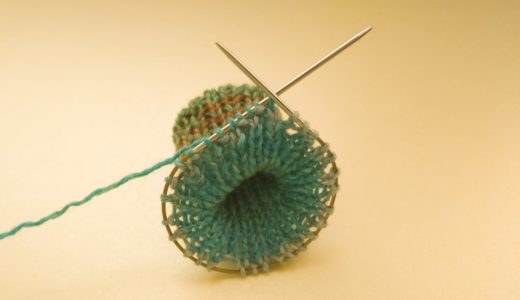
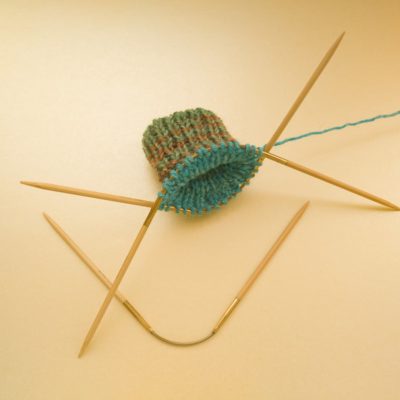
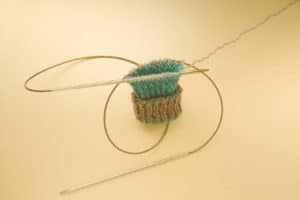
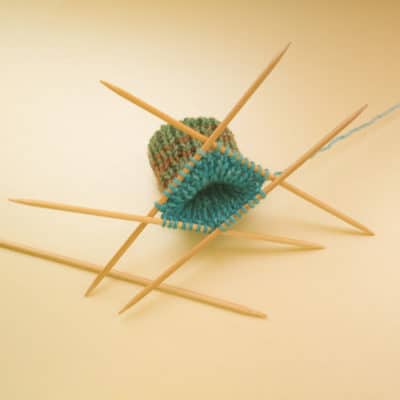
Tip: Which needles are particularly suitable for very small diameters
Very small diameters, for which a circular knitting needle is too long, are traditionally knitted with Double-pointed needles . For particularly small baby socks, it is best to use a short 15 cm set of needles.
But not everyone likes this technique and there are good alternatives, especially for beginners.
How about the addiCraSyTrio? This flexible set of needles consists of just three needles that bend in your hand, making them much easier to hold. They make it easy to knit any diameter, no matter how small. Find out more about the Trio
For small hands there is also the mini circular needle addiSockwonder. Here you have no transitions between needles and can easily knit any pattern with ease. The diameter of the Sockwonder is too large for very small baby socks, so the needle is suitable for shoe sizes EU 26/27 and up.
Do you only have a circular knitting needle? Auch damit lassen sich mit der sogenannten „Wunderschlinge“ oder „Magic Loop Technik“ Socken und kleine Durchmesser mit einer klassischen Rundstricknadel stricken.
Knit baby socks - Cast on stitches
Here we go. Cast on (36/36/40/40) stitches in Long Tail Cast On. Tip: Are you a beginner? Find out how to do it in this Long Tail Cas On (video german) by Sylvie Rasch or in the photo gallery.
- addiCraSyTrio: Distribute half of the stitches on each of two needles.
- Double pointed needles: Cast on 1/4 of the stitches on each of four needles.
- addiSockenwunder: Cast on all needles on the circular needle.
Cuff and leg
Close the round and knit a 5 cm long cuff (or optionally longer if it is to be wrapped around later). The cuff and leg of this sock are knitted in a continuous pattern to improve the fit for the baby's foot.
Choose one of the patterns from the pictures and knit the information between the *...* continuously in the round until the leg has reached a length of about 5 cm.


Cuff and leg
Close the round and knit a 5 cm long cuff (or optionally longer if it is to be wrapped around later). The cuff and leg of this sock are knitted in a continuous pattern to improve the fit for the baby's foot.
Choose one of the patterns from the pictures and knit the information between the *...* continuously in the round until the leg has reached a length of about 5 cm.
Which knitting patterns can be used for baby socks
We recommend knitting patterns that stretch well so that the socks will grow with your baby. Thanks to a stretchy pattern, the sock fits even if it is still a little too big and can adapt well to baby's feet and legs.
Extra stretchy sock pattern:
- Ribbed knitting
- Spiral ribbed knitting
- Seed ribbed knitting
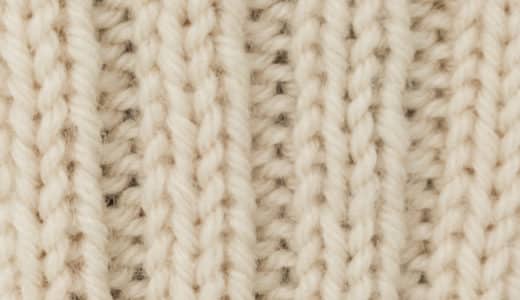
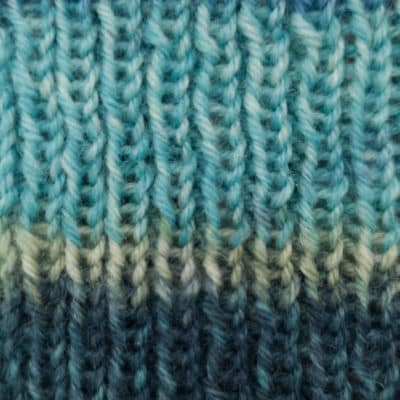
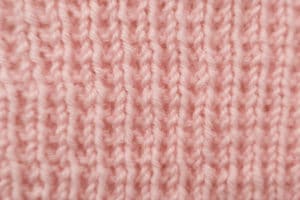

Which knitting patterns can be used for baby socks
We recommend knitting patterns that stretch well so that the socks will grow with your baby. Thanks to a stretchy pattern, the sock fits even if it is still a little too big and can adapt well to baby's feet and legs.
Extra stretchy sock pattern:
- Ribbed knitting
- Spiral ribbed knitting
- Seed ribbed knitting
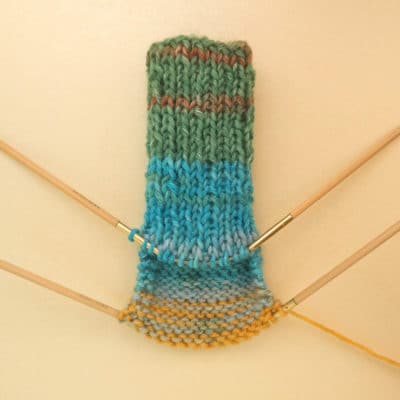
Knitting the Classic Heel – with flap-and-gusset technique
- Sockwonder = half of the stitches (optionally mark with a stitch marker)
- addiCraSyTrio = the stitches of one needle
- Double-pointed needles - The stitches from two needles. With DPN it is best to knit the stitches for the heel on one needle. This makes it easier to handle.
How it works: Classic heel - Part 1 heel flap
- You work your heel flap in stockinette stitch. Knit all stitches on the right side. On the wrong side you knit the first and last 2 stitches and purl the stitches in between. This way you get 2 garter stitches.
- Knit the heel flap for (16/16/18/18/20) rows as indicated in the chart.
Once you have finished your heel flap, the heel turn begins. To do this, divide the heel stitches over which you have knitted the heel wall into 3 equal parts:
-
- Size 17-18 (UK 3-4 JNR): 6/6/6 stitches
- Size 19-20 (UK 4-5 JNR): 6/6/6 stitches
- Size 20-21 (UK 5-6 JNR): 7/6/7 stitches
- Size 22-23 (UK 6-7 JNR): 7/6/7 stitches
- Size 24-25 (UK 7-8 JNR): 7/8/7 stitches
Note: A boomerang heel can also be knitted as an alternative to the classic heel
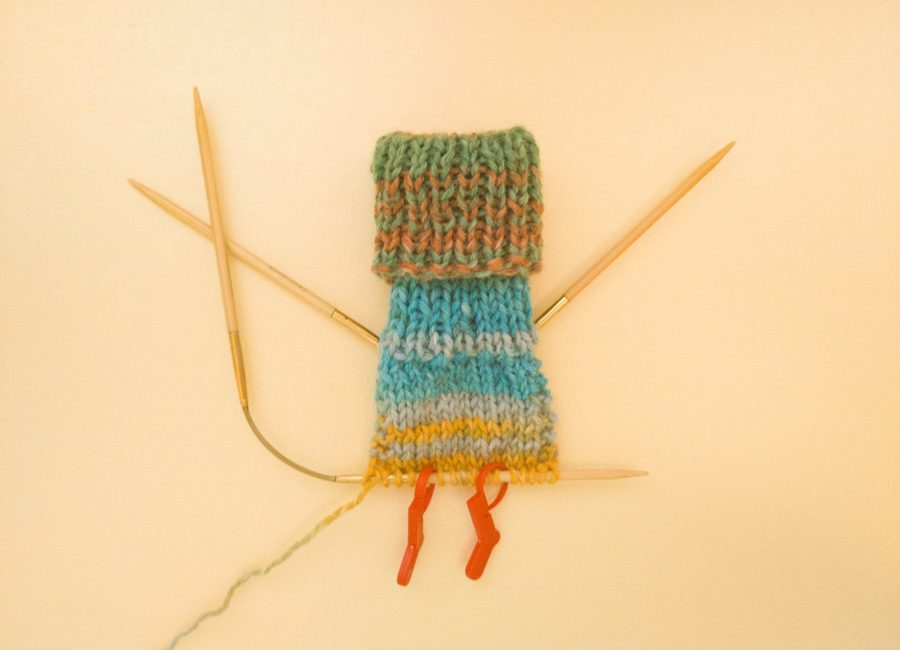
Knitting the Classic Heel – with flap-and-gusset technique
- Sockwonder = half of the stitches (optionally mark with a stitch marker)
- addiCraSyTrio = the stitches of one needle
- Double-pointed needles - The stitches from two needles. With DPN it is best to knit the stitches for the heel on one needle. This makes it easier to handle.
How it works: Classic heel - Part 1 heel flap
- You work your heel flap in stockinette stitch. Knit all stitches on the right side. On the wrong side you knit the first and last 2 stitches and purl the stitches in between. This way you get 2 garter stitches.
- Knit the heel flap for (16/16/18/18/20) rows as indicated in the chart.
Once you have finished your heel flap, the heel turn begins. To do this, divide the heel stitches over which you have knitted the heel wall into 3 equal parts:
-
- Size 17-18 (UK 3-4 JNR): 6/6/6 stitches
- Size 19-20 (UK 4-5 JNR): 6/6/6 stitches
- Size 20-21 (UK 5-6 JNR): 7/6/7 stitches
- Size 22-23 (UK 6-7 JNR): 7/6/7 stitches
- Size 24-25 (UK 7-8 JNR): 7/8/7 stitches
Note: A boomerang heel can also be knitted as an alternative to the classic heel
Part 2 - classic heel - heel turn
- First knit the stitches of the first third, then the stitches of the second third until the last stitch. This last stitch of the second third is not knitted, but knitted together with the first stitch of the last third:
- Make one stitch knitwise.
- Knit first stitch of the last third, pass the slipped stitch over.
- The other stitches of the last third remain unknitted.
- Now turn the work and knit the wrong side. The first stitch is slipped and the second to penultimate stitches are purled.
- The last stitch of the middle third is now purled together with the now first stitch of the first third. Just imagine that the two stitches are one stitch and that you purl them normally.
- Now turn the work again and slip the first stitch. If you look closely, there are 2 gaps where the stitches were worked together on the right and wrong row and slipped off after turning.
- From now on, on the right side you knit up to one stitch in front of the gap and knit the stitch in front of the gap together with the stitch behind the gap.
- Then turn, slip the first stitch and purl until one stitch before the gap.
- Then purl together the stitch before the gap with the stitch behind the gap.
- Repeat this process until only the stitches of the middle third are left.

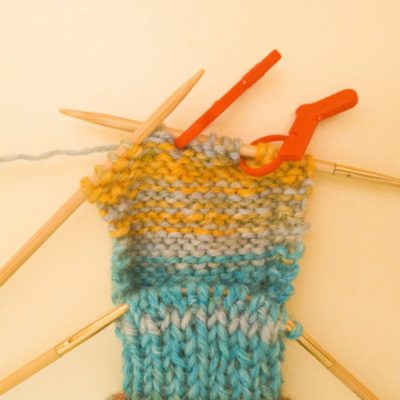
Part 2 - classic heel - heel turn
- First knit the stitches of the first third, then the stitches of the second third until the last stitch. This last stitch of the second third is not knitted, but knitted together with the first stitch of the last third:
- Make one stitch knitwise.
- Knit first stitch of the last third, pass the slipped stitch over.
- The other stitches of the last third remain unknitted.
- Now turn the work and knit the wrong side. The first stitch is slipped and the second to penultimate stitches are purled.
- The last stitch of the middle third is now purled together with the now first stitch of the first third. Just imagine that the two stitches are one stitch and that you purl them normally.
- Now turn the work again and slip the first stitch. If you look closely, there are 2 gaps where the stitches were worked together on the right and wrong row and slipped off after turning.
- From now on, on the right side you knit up to one stitch in front of the gap and knit the stitch in front of the gap together with the stitch behind the gap.
- Then turn, slip the first stitch and purl until one stitch before the gap.
- Then purl together the stitch before the gap with the stitch behind the gap.
- Repeat this process until only the stitches of the middle third are left.
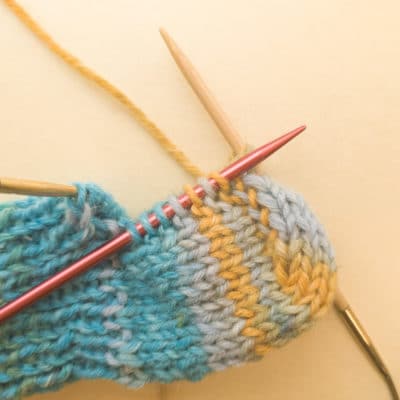
Part 3 - classic heel - sock heel
Now knit in the round again. To do this, knit the stitches in the middle third, then pick up a stitch from the left side edge of the heel flap from each knot and knit.
- Once you have picked up all the stitches on the left side edge, place a stitch marker (sockwonder) or continue knitting with the next needle when using double pointed needles and trio.
- Now knit all the stitches that have been dropped (in the pattern) (and then place a stitch marker for the sockwonder). Continue knitting with the next needle on the double pointed needles.
- When you reach the other edge, pick up stitches again from the edge of the right side. To do this, also pick up a stitch from each knot, using a new needle in the case of a needle set. In a trio, the stitches can be picked up with an auxiliary needle and then knitted onto the first needle.
The beginning of the round is now in the middle of the heel stitches. You can mark this point with a stitch marker. If you knit with DPNs, you will start with a new needle anyway.
- Knit another round over all stitches, then the gusset begins.
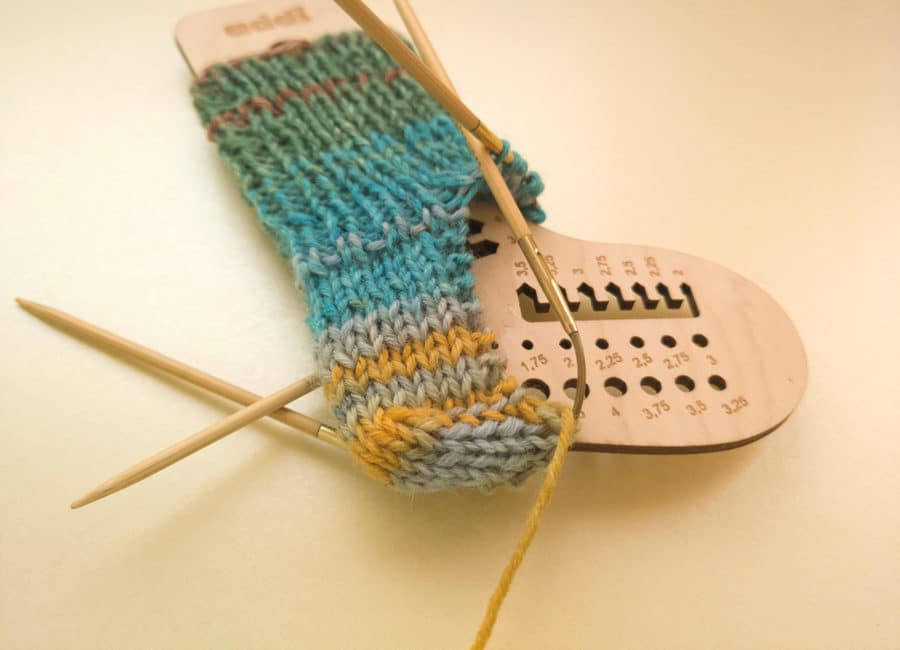
Part 3 - classic heel - sock heel
Now knit in the round again. To do this, knit the stitches in the middle third, then pick up a stitch from the left side edge of the heel flap from each knot and knit.
- Once you have picked up all the stitches on the left side edge, place a stitch marker (sockwonder) or continue knitting with the next needle when using double pointed needles and trio.
- Now knit all the stitches that have been dropped (in the pattern) (and then place a stitch marker for the sockwonder). Continue knitting with the next needle on the double pointed needles.
- When you reach the other edge, pick up stitches again from the edge of the right side. To do this, also pick up a stitch from each knot, using a new needle in the case of a needle set. In a trio, the stitches can be picked up with an auxiliary needle and then knitted onto the first needle.
The beginning of the round is now in the middle of the heel stitches. You can mark this point with a stitch marker. If you knit with DPNs, you will start with a new needle anyway.
- Knit another round over all stitches, then the gusset begins.
Part 4 - classic heel - gusset
- For this, in every 2nd round:
- knit to 3 sts before the next stitch marker (or until the end of the 1st needle of your DPNs)
- k2tog, knit until the next stitch marker or until the end of the next DPN
- k 1, k2tog, knit to end of round.
- This is followed by a round without decreases.
Now repeat these 2 rounds until you have the same number of stitches as on the shaft. This information is also in the sock calculator.
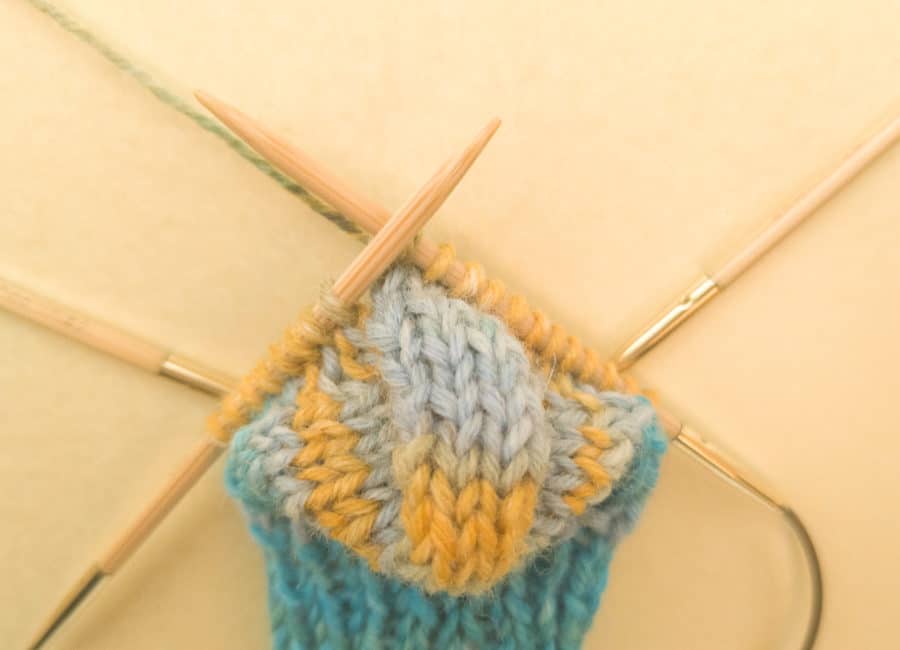
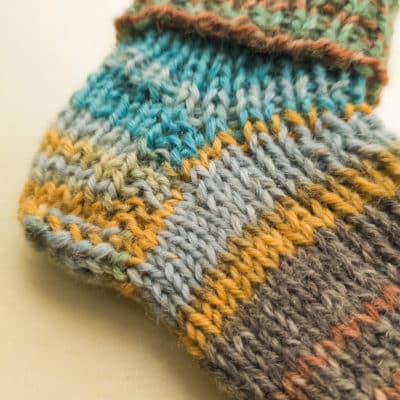
Part 4 - classic heel - gusset
- For this, in every 2nd round:
- knit to 3 sts before the next stitch marker (or until the end of the 1st needle of your DPNs)
- k2tog, knit until the next stitch marker or until the end of the next DPN
- k 1, k2tog, knit to end of round.
- This is followed by a round without decreases.
Now repeat these 2 rounds until you have the same number of stitches as on the shaft. This information is also in the sock calculator.
Knitting the foot
Once you have finished the heel, knit the foot section. This can be knitted in stockinette stitch or continued in the upper half with the pattern of your choice.
- Now continue working the foot in rounds until the required length according to the calculator (8/9/10/11/12 cm length including the heel).
The toe - finish the baby socks
Finally, the sock toe is worked. A classic toe is described here.
For the toe, decreases are made in two places - to the right and left of the toes. This results in a band that frames the toes.
Work decreases as follows:
| addiSockenwunder: | * knit to 3 sts before next marker, k2tog, k1, slip marker over; repeat from * 3 more times. |
| addiCraSyTrio | * knit to 3 sts before next marker, k2tog, k1, slip marker over, k to 3 sts before end of the needle, k2tog, k1; repeat from * 1 more time. |
| Double-pointed needles | * knit to 3 sts before end of the needle, k2tog, k1; repeat from * 3 more times. |
For the baby socks with 4-ply sock yarn, the decreases are distributed as follows (decrease distribution for other yarns in the sock calculator):
- Round 1: (decrease round) Work a decrease round.
- Round 2-3: knit all sts.
- Round 4: repeat round 1.
- Round 5: knit all sts.
- Round 6-9: repeat Rounds 4-5 twice more.
- From Round 10: Now knit the decreases in every round until there are only 8 sts left.
Note: Alternatively to the band toe, a propeller toe can also be knitted.
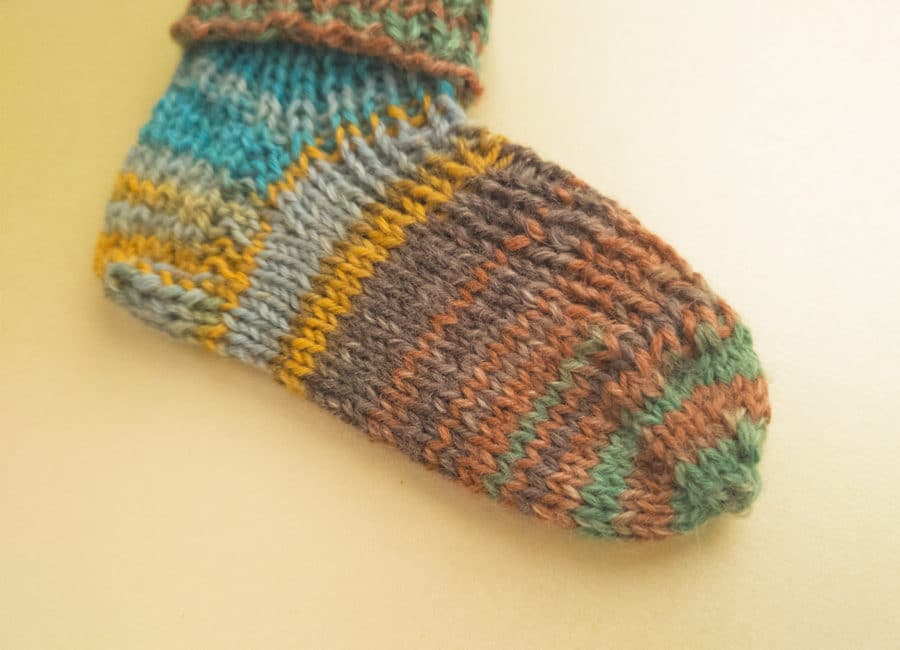

The toe - finish the baby socks
Finally, the sock toe is worked. A classic toe is described here.
For the toe, decreases are made in two places - to the right and left of the toes. This results in a band that frames the toes.
Work decreases as follows:
| addiSockenwunder: | * knit to 3 sts before next marker, k2tog, k1, slip marker over; repeat from * 3 more times. |
| addiCraSyTrio | * knit to 3 sts before next marker, k2tog, k1, slip marker over, k to 3 sts before end of the needle, k2tog, k1; repeat from * 1 more time. |
| Double-pointed needles | * knit to 3 sts before end of the needle, k2tog, k1; repeat from * 3 more times. |
For the baby socks with 4-ply sock yarn, the decreases are distributed as follows (decrease distribution for other yarns in the sock calculator):
- Round 1: (decrease round) Work a decrease round.
- Round 2-3: knit all sts.
- Round 4: repeat round 1.
- Round 5: knit all sts.
- Round 6-9: repeat Rounds 4-5 twice more.
- From Round 10: Now knit the decreases in every round until there are only 8 sts left.
Note: Alternatively to the band toe, a propeller toe can also be knitted.

